Wraith: The Oblivion by FelicityGS
Introduction
Original SA post
Welp, here we go!
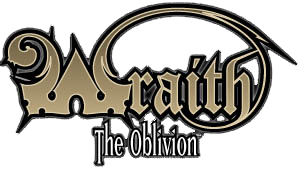
Wraith: The Oblivion
Intro and Intro Fluff!
Wraith was one of the main lines that White Wolf came out with in the 90s, and is arguably one of the better done lines. It's about being dead, and a ghost, and, like most of their stuff, 'personal horror.' I don't know if it was just that it had better writers working on it, or what, but a lot of the Wraith stuff is well above the rest. I remember fondly the games I had of, as well as steaming about how much the other players were being jerks.
But really, we all were, and none of us dropped the game until it came to a close, right around when most of us went to college and thus were divided by large masses of land.
It let us politic, adventure, and otherwise have a cool time, and we were all fans of ghost stories. It can be an admittedly depressing game to play, but you
are
playing a ghost. You know. In case you forgot.
I don't have a ton of pictures from it, because I have a physical copy and no scanner, but I will probably try to get at least a few photos as we go, because some of the art is pretty neat. Once we get to Charnel Houses of Europe (after the core book) I'll have more since I purchased it as a pdf.
And if anyone is still interested after all that, I might touch on their 'ending the world' book for this line, Ends of Empire.
Anyway! Enough Said! Let's jump right into our prelude, the intro fluff--and you other WW vets will be stunned to know it's actually mostly readable font on a mostly clear background! Madness!
The intro pretty much starts out with a basic overview of a few different things you'll end up being more familiar with. We've got a ghost who type writes stuff to us about the underworld, trying to go against the grain and reveal the truth of what's behind the Shroud. This is all narrated by two ghosts, distinguished by font type--one our flowery writer giving us the poetic and slightly more flowery version, and one in typewriter font, whose being snarky and a bit more forthright.
The Dead
Milord starts off going on about death and how it's the greatest mystery and being all reflective. Here, have a sample of how he writes:
Lord George posted:
Death has always been the greatest mystery of life. The undiscovered country from which no traveller has yet returned inspires fear and curiosity in equal measure. Some try not to think of it; others give over their lives to contemplation of what might lie beyondthe veil of death.
And yet, is death truly so mysterious? Surely, in all cultures from the beginning of time, there have been tales of the dead returning to the world of the living, impelled by some unfinished tsk or the well-being of a loved one, or revenge upon some enemy. Equally, there have been those who have, or pretened to have, the gift of seeing and holding converse with the shades of the dead, from the Sibyls of antiquity to the table-rappers and self-proclaimed psychics of more recent years.
Wherefore, then, is death so fearful, and so little known? For certainly there has been ample opportunity for the living to question the spirits of their dead, and to determined their condition and the nature of the world they inhabit. And yet the questions that have been asked are of so little import -- the location of a lost brooch, or whether the departed spirit finds the next world to its liking.
It's not unpleasant reading, but he does ramble a bit.
In any case, we learn that wraiths are not the only ones that left the living world, and that their on their way to Eternity. Surprise! Being a ghost isn't the end. Ghosts get chained by Passions and Fetters.
Passions are things that emotionally keep you bound--someone you love or wanting revenge on your murderer. Fetters are the material things keeping you bound, like a favourite ring, or a place where you died. More on these and their mechanics later. The Shadowlands are the realm of the ghosts, kind of like the kingdom.
Enfants are new ghosts, and are born in a caul. Not everyone can tear off their caul, and most don't. We also learn that souls are food and currency in the afterlife, and so sometimes Enfants are captured by wraiths that remove their cauls. Here, let's see what Ernest has to say on this:
Ernest posted:
It varies. There are good masters and bad masters. Some are sadists, and some are only in it for the money. There are a few who actually want to help. A Thrall owned by a powerful wraith is safe from other wraiths, and can learn how things work. Some masters see themselves more as teachers. A fair number even set their catches free. Mostly, though, it's business. Some things don't change on this side of the Shroud.
We then learn that this is still better than Lemures . These guys got out of the caul but have also avoided enslavement. They get picked on and hunted. And below them and the Thralls we have the Drones . These guys barely have form and don't have a will left. They just keep repeating the same actions over and over, chained by their Passions. These are the ones most people see.
Last mention in this section is the Domen , who don't have Fetters or whose Fetters broke and so are not able to get access to the Shadowlands, and the Guants , who have some passions still but are strong enough to safely travel beyond the Shadowlands.
The Shadow
Next up we have the other side of the coin--labeled id or shadow. It's all the bad things about yourself, and it's not hearable by any but you. It's a personal demon trying to drag you down and make you give up. The more you listen, the stronger it gets. Remember this is just an intro--there's a lot more we're going to hear about this; it's a pretty major mechanic, and why the game can be awful if the group isn't good.
We leave talking about people for a bit to hit up places--first the Shadowrealms .
The Shroud
The Quick is where we live, the humans, the land of the living. This brushes up against the Shadowlands. What divides them is the Shroud, and it varies in thickness. Even when it's really thin, it still hampers crossing between them. Everything across the Shroud looks like it's been decaying and falling apart, but still pretty solid. Everything is twisted for senses--you can see and hear these things, but they are distorted.
Nihils
Nilils are one of those special places where the realm of the dead affects the living. It's a hole in the Shadowlands connecting to the Tempest, and there are strange going ons there. We'll be learning more about the Tempest later (oh man, that must be a running theme!)
Haunts, Citadels, and Necropoli
These are places were usually a lot of wraiths gather, and often it's in old burial grounds or places of mass murders. Haunts are usually a house or maybe a street--think a haunted house where it feels spooky to be. Necropoli are, then, cities of Haunts. Not surprisingly, they are often abandoned or ruined cities of ancient civilizations, since those have fallen closer to death than cities like Chicago where lots of living still live. The biggest and strongest are Citadels.
Wider Underworld is next on our stop, and it has all the things that make Traveling Fun! as a Wraith.
Oblivion
Basically, this is the form and substance of the underworld. Lord George posits its a momentary stop for entropy before disappating and continuing to decay--another stage of energy and matter from across the Shroud. You can also think of it as the 'center' of the underworld, what everything will eventually end up at.
The Tempest
I told you we would talk about this later! It's basically a big ol' underworld ocean, which is always stormy and is always a pain to cross. It makes travel Fun. It also is swarming with Spectres , wraiths that have lost their freaking mind and are trying to drag everyone down with them. They can be wraiths that fell to their Shadow or those who were lost in the Tempest; there's a fair bit of debate about their origins. In any case, they are like pirates, with your mind as the treasure.
I'm going a bit out of order here to keep our nature with nature, and cover groups after--next up is the Maelstorms . Sometimes the Tempest decides it wants to be even nastier, and it is the equivalent of a tsunami and earthquake all in one. It can destroy entire Necropoleis, and it's almost always linked with some terrible event in the Quick--the fall of Rome, the Black Death, World Wars--you get the idea. Bad stuff in the living causes a chain of bad stuff in the dead.
Stygia is an island just chilling out in the Tempest. It's pretty tough, constantly being rebuilt after every major Maelstorm. You can run entire campaigns within just this city, it's that big and that important. It was founded by Charon, who lead it for a good long while.
Yes, that Charon, from Greek myth.
He's gone AWOL right now after a big fight, so we've got Deathlords and the Heirarchy now. We'll be visiting on them shortly.
Finally, in our places, we have the Far Shores . They are other islands in the tempest, like how Stygia is. Some people think they are Heaven, some think Hell, and some think they are scams to get gullible souls. It's dangerous and hard to journey to them, but it gives people hope, so naturally a lot of people believe and some are willing to do what they have to to get a ride out.
Now on to the People that make the land of Wraith such a great place to live!
Those same gullible people can sometimes belong to the Heretics . These are groups of wraiths, not really one major group, linked by like minded ideals. It might be hate of the Heirarchy, it might be a shared belief or faith. A lot of times one group of Heretics calls other groups that--very zealous 'my belief is the only belief!' Almost all of them claim to have the keys to Trancendence.
The Hierarchy , meanwhile, is the major governing body of the Shadowrealms. It was ruled by Charon for a good while, before he went missing in battle, and it pretty much functions as police, governor, judge, and all the nitty gritty beaurarcy that you need for society. At the head of the Heirarchy we have the Deathlords . The only person above them is Charon, as it's a fuedal model, and they are the big movers and shakers of politics and policy. They generally try to get as many dead enslaved to them as possible.
We also get the Guilds out of the Heirarchy, though some are banned. These are basically crafts of the dead, which have allowed them to make tools and coinage they need, to fend off the Shadow, and otherwise live. Wraith is pretty cool in that it's much easier to mix and match the different abilities--you don't have to have the right bloodline, just find someone to teach you. They are pretty secretive, and of late the Heirarchy is kind of opposed to them. They were originally founded by Charon organizing everyone who was good at particular things together, though of course politicking in the guilds suggests otherwise.
Renegades , meanwhile, are none of the above. They don't buy into Heretics and their beliefs, and they don't like the Hierarchy. Sometimes wraiths who just don't know what to do settle here. I suppose you could have a renegade part of a guild, since guilds are not strictly aligned with the Heirarchy.
Finally, the enigmatic not actually ghosts! Meet the Ferrymen . They are older than the wraiths, have been around longer than then. Charon was a Ferryman a long time ago, before Stygia was founded. It's rumoured he was even the first one--but none of the Ferrymen have said anything one way or the other. This is a trend, they are pretty silent.
Unlike a lot of things, no body can boss a Ferryman, they get to cross the Tempest whenever they feel like, and Spectres don't bug them at all. Of course, that might not be true--sometimes it's thought they go down when they go rescuing wraiths from the Tempest, which is one of the things that they do. A Ferryman boat is probably one of the safer places you could be, though, even if they do lose the occasional fight.
The last thing that our lovely introduction touches on is Trancendence . Almost entirely rumour, this is like vampire glaconda. It's redemption, the way for you to get out of the underworld. No one really agrees on how you do it, or what it is; some say it's letting go of your Passions and Fetters. Some say it's enlightenment, others good deeds. There are even stories of what it looks like, but those don't really agree either. The biggest role it seems to play is a source of hope.
Of course, who really needs that, can't you see from this brief tour that the Shadowlands are full of Fun and Great People?
Yeah.

Next time we skim over Chapter 1, the how to role play, and go on into Chapter 2, which has the nitty gritty of setting. It's got juicy details on history, the various factions, and all the glorious details that help make this game shine. It's a long one, though, so will probably be broken up in chunks--history will likely be an update or two away, but it's neat too.
Man I still love this game.

What’s this new Fangled Ar Pee Gee stuff?
Original SA post
Yes pick up the 2nd edition hardcover if you can find it, I've browsed the 1st ed before. It's not bad but it is missing stuff.
That said, another exciting edition of

Wraith the Oblivion
Chapter One: What’s this new Fangled Ar Pee Gee stuff?
Let’s start with a bit of introductory story bits--this is part of the ‘book one’ intro, and I think it helps set a little bit of tone for what Wraith is like. There’s a better story, but damned if I remember where it is in the book, so if we get to it, I’ll share.
”New Wraith” posted:
I didn’t meet her until after she’d died, but that’s all right. I was dead too, at that point. A wraith, technically. A ghost, doomed to haunt my former place of employment until... well. I didn’t know until what. It’s not like there are instruction manuals on being a wraith, no matter what the movies say. Didn’t do much haunting, either -- no one even knew I was there. No one living, that is. So I just cowered inside my haunt, eking out my little ghostly existence and praying that eternity would end quickly. There didn’t seem to be many other options.
But one night I looked out the window at where the other wraiths were congregating on the street below, and I saw her. And she, well, she looked up and smiled at me. But that wasn’t enough to get me to come down.
Then the ghosts of the soldiers came, and she couldn’t hide fast enough. Some ghostly butcher maimed her and carried her off. But that wasn’t enough to get me to come down. Not in time to help her, anyway.
In the end, I had to force myself out, for my own reasons. Finding her means more than anything now, even though I can feel the old office still pulling at me. But she’s still out there, somewhere in these lands of the dead, and I have to go find her. Just thinking of it fills me with strength I never had before. I wish I could explain it.
I will find her. And I will find the man -- ghost -- who hurt her. And when I do, he’ll find that there are far worse fates than being dead.
Indeed, new wraith, indeed. There are some pretty horrifying fates you can find in the lands of ghosts, and we’ll even cover some. This guy sounds so jaded and noir detective like, I swear there is one about a guy who doesn’t sound kind of like a gruff guy stirred to action by a lady.
In any case, chapter one! Every. Single. White Wolf book has one of these, and they all say something about how it’s ‘personal horror’ and all that. Like Purple commented, Wraith actually is about personal horror! It’s not about winning or losing--though you can certainly ‘lose’ in the sense your ghost can go apeshit or lose to the shadow.
Story telling is White Wolf-ese for DMing; roleplaying gets defined. I’m pretty sure you guys know what that is. We get told the story is the important thing--and without oodles of railroady White Wolf lore to back it up, this core book alone pretty well emphasizes that I think. You can entirely ignore the metaplot--which I most certainly did--and be content.
Story tellers, then, are DMs. Oh, and just to prove that some people actually at least understand this in theory:
”One of the 16 People Who Wrote This Book” posted:
The Storyteller’s most important role is to ensure that everyone enjoys themselves. That means telling a good story involving all of the characters, treating characters and players fairly and equitably, and listening to what happens in your world as well as creating it.
As we’ll learn, the game can be unfair and jerkish enough without needing to have Storyteller out to sabotage you.
In turn, we have Players, those are the dudes playing your game. These play the characters, and it talks about how you need these guys to be fleshed out. The best stories in Wraith come from the roleplaying.
There’s a text box aside, and it basically spoils my favourite part of Wraith. It’s about shadows, so let’s give it a pass for now and we’ll come back to it. It’s only a few sentences anyway.
We get told about live action, what sort of rules there are (common sense stuff like ‘don’t touch’ and ‘no weapons’ and ‘respect those not playing’).
We get a little blurb on some neat things about wraiths. Things like how they can see how far Oblivion has touched someone or something, and it’s good for figuring out how healthy someone is. They can read auras of the living. Your senses are super sensitive, but it points out that loud noises and big booms can stun or confuse wraiths. And, the best bit of being a ghost, being insubstantial. Not able to interact without extreme effort with the world you use to know. How sad.
At last the Shadow. Ok, so that text box was only a page ago, but it makes more sense to introduce the cool stuff here.
We’ll cover this far more in-depth later--there’s an entire chapter on it--but as mentioned before this is the voice trying to tear down your wraith. Basically a character unto themselves, they get their own powers (Thorns) and spend loads of time trying to weaken their other half (Psyche)(you are basically the Psyche).
Even the best offers are just trying to destroy you. It’s the easy way out of problems, and sometimes the only way.
Also, someone else at your table is playing them. Probably your best friend. This can easily make for some of the coolest roleplaying and situations. See, since they are characters, you need a person to play them, and who better than someone at the table who isn’t the story teller?
This can get pretty overwhelming. Also, why this can be the worst thing if you don’t have the right group:
”Wraith” posted:
Of all the conflicts that a wraith faces, her struggle with her own Shadow is the most vicious and terrible. There is no respite from the voice whispering in her ear, no cessation of the hostilities possible. The greatest triumphs a wraith achieves and the worst defeats that she suffers will come on the battlefield of her own soul.
In a bad group these conflicts can overtake the table and destroy friendships; it’s not really a shock that some people who rp have poor social skills and so don’t get why constantly backstabbing you and making the game about that is bad. Really, your character should probably be more developed and roleplayed more than the shadow you also play.
In a good group, it’s often lying in wait in the background until you’ve nearly forgotten--and then the other dude at the table sees a moment and strikes. You still probably will think they are a jerk, but it makes for a good story.
You probably shouldn’t let people play each other’s shadows. Just saying.
There’s no suggested reading list for this, though there is a huge lexicon; I’ll cover the terms as we need them. Here, if you really want, here’s who they dedicated the book to:
Edgar Allan Poe
H.P. Lovecraft
Ray Bradbury
(I think this book is more Lovecraftian than CthuluTech)
(I’m not exactly setting the bar high, am I?)
Next time : We start on Chapter 2 and all the delicious delicious fluff. Good news, there are hardly any mechanics, as far as I recall. No telling you you lose Corpus before you even really know what that means!
Setting-- The Underworld
Original SA post
Wraith: The Oblivion
Chapter 2, Part 1: Setting-- The Underworld
Chapter 2 is all about the setting that Wraith takes place in, and it’s a huge chapter. I’ll be dividing it up into easier to discuss chunks, as I have no desire to write forever.
Like most settings of oWoD, this chapter opens up by pointing out this is like our world but darker and edgier. Good news--since everyone is dead and the real world is only sort of interactable with to the ghosts, we don’t deal with all the Drugs and Woe Is Me (but not really cause I can throw trucks!) that seems to happen so often in the other settings. So Wraith actually is a bit darker and edgier.
The film noir vibe that WW describes these cities happening is, in my opinion, a pretty good thing for you to run for. Film noirs aren’t really horrific, but those cities could certainly give you the spooks. The balance between Gothic and Punk is kind of up to each game group. Look, we’re already done with the living for now!
The Underworld is the Far Shores, the Tempest, Stygia, and the Shadowlands. Technically it would include the Dark Kingdoms, but we’re just going to ignore them and say they aren’t since they don’t really impact day to day life. (The Dark Kingdoms are basically the other Underworlds of other cultures)
We get another run down on what Oblivion is (the passive patient aspect of destruction all things wraith spiral towards), but we also get some news that it’s apparently sucking souls down faster and more strongly than it ever has before. There are more spectres, more Maelstroms, and Oblivion is basically getting bigger.
The sort of opposite, the material that you build with, is souls. No, it’s not a metaphor. They literally take wraiths and melt them down or reshape them. Coinage is oboli , and apparently they moan when you hold them.
 Oh, and some people say that anyone soulforged is still aware and will suffer endlessly. Yet the trade persists because economics!
Oh, and some people say that anyone soulforged is still aware and will suffer endlessly. Yet the trade persists because economics!
 People naturally try to sugar coat it, but the biggest thing is there isn’t really an alternative, so they just keep on enslaving new or weak wraiths and either using them for labour or smelting them.
People naturally try to sugar coat it, but the biggest thing is there isn’t really an alternative, so they just keep on enslaving new or weak wraiths and either using them for labour or smelting them.
Of course, there are relics , objects that are basically emotionally vested--like a your favourite stuffed animal, say--and when they destroyed they appear. Wraiths can’t pick and choose, and it’s almost always something nonessential. Yeah, maybe you had a favourite gun, but I bet you didn’t have favourite bullets.

Artifacts are things that come directly from the Skinlands (aka where there be living people), and they are usually invested with special powers. They are pretty damn rare though, and often tightly controlled by the owner.
So, when the only two resources that aren’t souls are rare, you get souls. They can make nearly anything, and one of the powers is based around forging them--it’s called Moliate. Not everyone gets screwed when they come over, otherwise there would be no game or society.
Here, have a horrifying picture of this process that still makes me cringe (sorry for shitty pic, but I had to share):
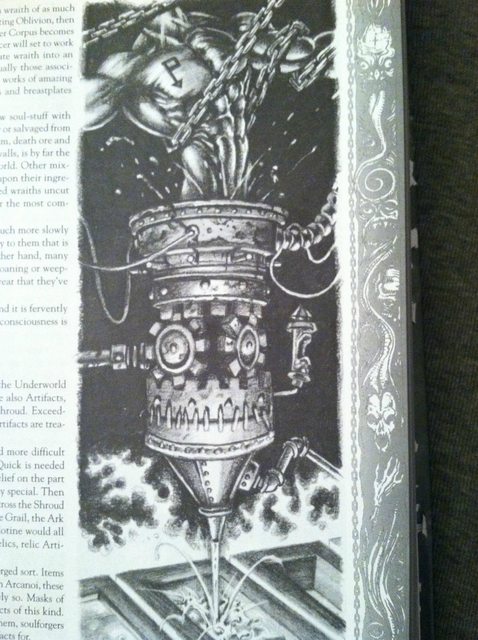
These sections don’t seem very well organized, so let’s just sort of edge past this awkward break into the next.
Now, the geography of this place is what made me really laugh at the thought of a Wraith LARP.
”Wraith” posted:
Known by many names but never mapped, the Underworld does not exist as a “place” in the way that the living view geography. Instead, it is a non-Euclidean nightmare to any who think that a straight line is still the distance between two points. Even most wraiths don’t quite understand the nature of the realm in which they dwell; they tend to resort to models of increasing simplicity and inaccuracy in order to explain their surroundings.
Basically, just pretend it’s a tiered layer cake with all the holes and tunnels in the delicious layer creating the points between things in that layer. The top tier is the Shadowlands, and it mirrors the human realm. The next tier is the Tempest, which is that nasty storm that’s been going on for apparently half a millennium? Isn’t a millennium not that long a time, relatively speaking? Well, ok, whatever you say Wraith.
Byways are paths of relative safety that lead between different areas of the Shadowlands or deeper. Hell, this sounds more like the Shadowlands is a really crappily done and uneven frosting. You can travel without using the byways, but it’s not a good idea. You get all the nasties. Of course, nasties can spill onto the Byways, so it’s really how much you want to bet.
Islands of stability exist, like where Stygia is and the Far Shore. Usually around these islands the Tempest is a pretty calm ocean, and there’s loads of traffic.
Deep inside the Tempest--so the inner layer of our crappily frosted cake--is the Labyrinth . No one knows where it’s from or what it’s made of. The passages change as you walk through them, and there are things from all points of history in it. This is where the Old Ones sleep. I’m only sort of joking, it’s where the biggest and nastiest Spectres are, called Malfeans.
And, at the very bottom, we have the Void . It’s the center of Labyrinth, and the source of what’s pulling everything in and down. No one who has ever gone in has come out.
Then we cover all that stuff I covered in the Prelude. Again. That makes three times now. The highlights:
-
The more emotion in the Skinlands attached to a place, the more defined it is in the Shadowrealms.
-
The Shroud is strongest where people are all reasoning and not superstitious.
-
Haunts are usually defended by a strongly knit circle of wraiths.
-
Stygia is basically forged out of every city ever, from Carthage to New York and London. And it’s literally just stuff stacked on top of other stuff, so hope you aren’t a claustrophobic.
-
The Tempest is a pleasant place, randomly erupting with fumes, tar, horrible visions, raining broken glass or lava, and echoes of memories of those swallowed by it.
-
Necropoli are usually the bad bit of town, and the local hot spot for Wraiths to trade and hang out. They center on a Citadel, which is just a castle to hole up if shit goes bad.
-
The Far Shores are both a scam and sometimes not. You get crazy dudes with tyranny and good places.
Here’s some newer stuff:
We covered Nihils briefly before, but there’s a bit more depth now. Nihils are basically where the Tempest manages to bubble through, like a whirlpool but worse. It allows direct access to the Tempest from the Shadowlands. A few are permanent, some close and open regularly on cycles, and some are one time events. They’re usually surrounded by Spectres. Mostly they aren’t actually that big--maybe a few inches, topping out a few yards. It’s rumoured gazing into them will make your Shadow stronger, via clever reference to Abyss gazing back at you.
We get an aside box about the Veinous Stair, which isn’t a Nihil, but basically goes straight from Stygia to the Labyrinth. It’s made of black stone with pink veins that writhe all creepy like. Charon’s the only dude to make it to the bottom (Charon might be a badass), but they make slaves mine it for the ore. You can go about halfway down pretty safely. No one knows what the fuck it’s doing.
There’s a bit more Maelstroms, mostly how getting caught in one will start tearing your very being away . Don’t get caught in one. The worst Spectres usually are riding in it too. It often heralds bad shit happening in the Skinlands, or is the result of that. They get used as the major units of time, so we’re in the Fifth Great Maelstrom, which was caused by the bombing of Hiroshima. The time between these keeps getting smaller.
Our final stop this evening is Domains . This functions a bit like a vampire domain or werewolf territory. It’s basically the amount of territory that a wraith or circle of wraiths can control. They get officially doled out by the Hierarchy, and they mark it out with freaking immobilized slaves forged into flaming torches. Jesus fuck.

Course, wraiths can make their own claims, and the Legionnaires (the military of the Hierarchy) aren’t dumb enough to go in unarmed. Most of the domains claimed by circles can be backed up pretty easily.
Next time on Wraith: the Oblivion The Nature of Wraithness and some society!
Wraiths, What they are, and How Stuff is Made
Original SA post
Oh man, Birthright is pretty cool, and I will nth the want for more fluff.
So after screwing off for the weekend and catching back up with the thread, it’s time for more

Wraith: The Oblivion
Chapter 2, Part 2 -- Wraiths, What they are, and How Stuff is Made
So I forgot to mention something cool the Ferrymen made last week. It’s called the Midnight Express (this is pre-Harry Potter by at least a year), and it’s an artifact they made out of a steam locomotive and tons of railroad cars. All the cars were destroyed violently, and that’s about the only thing they have in common. It always pulls in at exactly midnight local time, and it can do it at multiple places at the same time. So if you want to run your own Grim Fandango game, you can!
With that, let’s get on with detailing the ghosts. We get a bit more on how wraiths straddle the line between Oblivion and life, and how each action is a shout of defiance. It’s kind of a true thing, though, since everything in the Underworld is pretty much conspiring to try and drag you down.
Most wraiths want to interact with the Skinlands, but as we’ll learn, that’s taboo. Passing through objects is a little difficult, though you can expend some of your Corpus (health) and you can walk right through. Course, that means it’s pretty hard to actually push anything--you’re body is much more inclined to discorporate. Things in the real world, for the most part, have a very difficult time hurting a ghost. Conversely, the Underworld is full of stuff that can tear you apart and cause lasting damage. Soulsteel is going to cut just like real steel does to the living.
There are naturally Arcanoi (ghost powers!) that let you do stuff in the real world. Some will let you become a poltergeist or a literal ghost in the machine, some will let you actually possess people.
The things that are going to define your existence are passions and fetters. Fetters are what you cared about most in the real world, Passions are what you most want to do. Fetters are basically anchors, things you can tie yourself to to resist Oblivion. This is basically where you can heal and take a break; if it’s destroyed though, you are pretty well fucked. We’ll get into the details of Fetter destruction down the line.
Passions are what fuel you. It’s basically an emotion that’s driving you along. It creates an energy called
Pathos
, which is what you expend to use your Arcanoi and heal.
Expanding from the micro scale to the macro, let’s talk about society a little (we’ll cover this much better next update). Wraiths have a pretty rigid social structure for being dead and all, and it’s based around age, power, how good you are at ghost powers, and freedom of movement. You get some that’s just letting you know what you’re dealing with, but some wraiths treat it like high school and won’t deal with someone who isn’t the right ‘sort’. Mostly it’s the old guard in Stygia keeping this up.
Basic run-down of the various social statuses:
-
Enfants -- The newly dead who aren’t used to the Shadowlands. Usually still in their Caul, they are stuck in a blur of distorted senses.
-
Drones -- Wraiths the living are most likely to see; they just get stuck at the site they died and just keep repeating forever.
-
Thralls -- Slaves, basically. You get dudes captured, some who are sentenced for crimes, and a few real bright dudes who sell themselves into it as indentured servitude. Nothing’s really making anyone keep that contract though. They usually can’t travel freely without their masters. More die to Harrowings (more on that later, think of it as ghost psychological breakdown) or their Shadow than get smelted or freed.
-
Lemures -- Wraiths with newly removed Cauls and still have their Fetters. They make up the majority of wraiths in the Shadowlands, since they want to keep watch over their Fetters.
-
Domens -- Wraiths that can’t travel the Shadowlands freely (probably due to Fetter loss), they have to stay in Stygia or other places of safety. Really old ones are treated with respect, but young ones usually not.
-
Gaunts -- Old wraiths who have managed to keep their Fetters. They usually have also traveled to the Far Shores or far into the Tempest. They usually have oodles of influence, but there aren’t very many of them.
-
Deathlords -- These were originally Charon’s Senate. They each have a legion and throne. Now that Charon’s gone they usually compete with each other. A few will encourage deaths in the skinlands to help swell their ranks.
A Reaper is basically the wraith who cuts the Caul off an Enfant. Most are pretty nice, though some are recruiters for their gang. Even the ones trying to recruit you are still pretty nice and give you a good intro to wraithdom.
There are slavemasters who just try to reap as many as possible so that they can sell them to the highest bidder. Enfants picked up these Reapers are usually pretty screwed.
You usually can find them at places where people die, like hospitals, prisons, and retirement homes.
The physical possessions of the dead are covered in the next section. It covers what items there are and what they are made of.
Most are made of souls, the first method by being hammered/smelted in the soulforges; some are mixed with death ore, which is mined from the Veinous Stair, which is for special things or war items. Some are Moliated, which is one of the Arcanoi which allows a wraith to mold another’s corpus. This is for furniture and stuff; things that would be wood or softer are Moliated, while the rest is soulforged.
In order to stop souls from going to Oblivion, all the Deathlords (and Charon did this too) order for all weak, Passionless, and counterproductive wraiths be smelted down. Counterproductive can include Renegades and Heretics, naturally, since they don’t fall in line with the Heretics.
Soulforged items are what you have to make just about everything from--cinderblocks, swords, and so on. You have to drain a wraith of as much sentience and will without tempting Oblivion, and then hold him over crystals of soulfire until his Corpus becomes soft and malleable. Then an Artificer will hammer the wraith into a whole new form. Really skilled Artificers can make stuff of great beauty and delicacy--think fancy blown glass--as well as your bog fare construction materials.
Stuff forged with death ore is called Stygian steel , and it’s the strongest known substance in the Underworld. You can use different mixes for different effects; soulsteel is stuff that isn’t mixed with anything. All of these break down much more slowly than relics; course, wraiths also claim that they can hear moaning or weeping from these items. It is an irreversible process.
The third group is relics. These are memories of things brought over after stuff is destroyed in the real world. Most of the buildings are relics, just soulforged together with other objects. It matters how much strength of emotion is behind it, not what the emotion is. So you get lots of teddy bears and knives, handcuffs, and buildings like schoolhouses or prisons.
Making a relic is pretty easy--you bury or destroy the object that evoked the strong feelings. Usually it will appear in the exact same spot in the Shadowlands. It’s a sort of ritual to gift your relics you brought with to your Reaper, especially if he wasn’t an asshole and didn’t sell you into slavery.
All relics eventually fade away; the stronger the feelings the longer they will last though. Most of them aren’t ‘useful’, since most tend to have more sentimental value. Really useful stuff, like cars or working computers, tend to vanish after about 10 years. You still need to use Pathos to make them work.
Some relics have lasted for centuries or millennia. Stuff like Brutus’ dagger or da Vinci’s doodle pad have created enough passion in the Skinlands to last.
Artifacts is a catch-all for items with special powers. They can be either relic or soulforged. These are highly sought after.
Relic ones are are hard to make and harder to hang on to. You need the passion of millions to get a relic so empowered, and the people have to also think it’s special in some way. Then destroy it; Excalibur, the Grail, the Ark of Covenant, and the original Mme. Guillotine would be examples. These will never fade away.
The others are soulforged sorts--we see a sort of example of this with the ferrymen’s Midnight Express that I opened with. They are invested with some sort of Arcanoi; masks of office and Anacreons’ swords(we’ll find out about them) usually are Artifacts. Soulforges are usually pretty picky about who they make them for since it’s a huge personal investment.
Some standard items that wraiths would be familiar with every day are:
-
Weapons -- Swords, knives, and simple weapons that require no Pathos and no ammo. Ornate ones are status symbols.
-
Oboli -- The base coin of the Stygian currency. It’s one soul. They are often used by Heretics and Renegades since they don’t have an alternate currency. You can chop them up for change, but they tend to reform as soon as they can. Scattered bits of random change will never reform. Not to mention the effects on the smelted soul of being chopped to bits.
-
Manacles and Chains -- These are a staple of Reapers. They are usually imbued so that wraiths can’t use their powers to escape.
-
Masks -- These are used to depersonalize offices. They get passed down to succesive holders; even Deathlords are only known by masks and other badges.
The final thing we’ll be covering today is Deathmarks . They used to be used by Ferrymen to tell what type of person they had been and recommend the best route to Transcendence. Heretics have been banished though and Transcendence is said to be a lie, so the original point is ignored. Now it’s used to try and classify wraiths by how they died. Some are now branded to mark what Deathlord they belong to. Naturally, you get some whackos who Moliate themselves in the extreme to proclaim loyalty.
That wraps up this kind of hodgepodge collection. Next update we’ll be talking actual Society, including factions, Charon’s laws, outsiders, Ferrymen (again!) and spectres (again!).
What Gang Are You In?
Original SA post
Pendragon is freaking awesome so far. And I'm totally gonna reread the Le Morte d'Arthur again, it's been awhile.
I swear we're getting close to done with fluff, but here, have more!

Wraith: The Oblivion
Chapter 2, part 3: What gang are you in?
Not surprisingly, society has formed on the other side of the veil. People still want to socialize with each other, and so that leads to a bunch of different groups that you can be part of. Course, with people coming from all over...
”Wraith” posted:
Stygia is based on a classical Athenian ideal, overlaid with a Roman Republic structure with trappings of Empire and coated with modern notions layered over standard European feudalism.
So there’s that.
Smaller groups of wraiths are called circles , and this is like the werewolf pack. They are usually very tightly knit, because no one else is going to watch your back, often bonding over shared haunts, Spectre attacks, and so forth. Groups are usually between 3-30, but it’s rare they ever get bigger than that.
Factions are exactly what they sound like. For the most part people don’t really pay attention to your faction when it’s a one-to-one interaction, but you probably should still be careful who you express sympathy for in front of people you don’t know.
The broadest of terms is for Renegades , which covers anyone outside the Hierarchy and not in a Heretic cult. Many are part of some sort of gang, but there really isn’t one average for renegades. Some are Legionnaires that grew jaded and quit the system, some are trying to fight against the soul-slavery rampant to the Hierarchy. You get lots of mercenaries, but you can also find some peaceful groups too. This whole mess of divisions is what keeps them from effectively rising against the Hierarchy they don’t like so much.
There are some pretty well-known groups:
-
The Brotherhood of the Black Rabbit--Former stage magicians, they banded together to protect their like from being abused by the Hierarchy. They usually keep studying the occult and supernatural, and work with mortal mediums. They also occasionally play diplomat to the Dark Kingdoms.
-
StormRiders -- These are biker gangs. No, seriously. They often have relic cycles, and a lot are all Robin Hood of helping the weak and screwing over the strong.
- The Flying Column-- A Dublin-based group that are trying to liberate the Dublin Necropolis from the Hierarchy.
The other disorganized faction is the Heretics , so labeled by Charon after he discovered the Far Shores and what they really are. Most cults will assign the name to all others not in their cult. A lot are sustained by faith, much like others are sustained by Pathos. The main reason they can’t join together is because none of them will even slightly cede that maybe other beliefs have a place or could be right.
Mostly, they argue about Transcendence. Charon said it’s a lie after some stuff, but that only added fuel to the fire for a lot of the Heretics.
A few well-known cults are:
-
The Host (not the Stephanie Meyers book) -- They think they are angles. They think they are still ghostly because they aren’t quite worthy of Heaven yet. They try to screw with the Skinlands a lot; we get some wink wink nudge nudge about how people started to believe in angels more after they were formed.
-
Children of the Green -- Neo-pagans or converts in death. They think they embody a smaller Wheel that works from the bigger one as a sort of pulley. They’re usually pretty militant about trying to fix everything by lunch.
- Riders of the Wheel -- These guys used to be all about Fortune’s wheel (I guess they were gamblers?), and now they leave everything to Chance. They have the Hanging Gardens casino from the Shadowlands of Atlantic City as a temp to Chance. They gamble.
The Hierarchy is the best organized of the three factions, and thus why it has the biggest claim on the Underworld. Charon originally founded it as a means of organizing and unifying the afterlife, but it’s gotten pretty, well, bureaucratic. A lot of people think they are the best bet to avoiding being destroyed by Oblivion, seeing as the Legions manage to keep everyone mostly safe.
Mostly, this is where the average wraith ends up. It’s closest to average life of the living, too. The lower levels of the Hierarchy are even mostly not corrupt (unlike the highest levels), and generally this is where you get your daily drone of pushing papers and the like.
The Hierarchy is divided into different Legions , each overseen by a Deathlord. Legions are mostly made up of guys who never put on armour or wield a sword, though that is the most public face. The military side is the one that helps maintain safety of the byways, Spectre-hunting, and other things you need military for in the Underworld. They usually don’t clash, though if it’s out of the way enough they might if their respective Deathlords aren’t feeling too cheery with each other.
You get some smaller ‘legions’, which are closer to orders. The 5th Legion, the Legion of the Black Hawk, is one made of the best soldiers from the Deathlords’ legions. If wraiths want to mention the smaller orders, they usually mention them by name since everyone assumes you mean one of the big eight.
The big eight are:
-
The Silent Legion, ruled by the Quiet Lord, for victims of Despair
-
The Legion of Paupers, ruled by the Beggar Lord, for victims of Mystery
-
The Emerald Legion, ruled by the Emerald Lord, for victims of Happenstance
-
The Grim Legion, ruled by the Smiling Lord, for victims of Violence
-
The Iron Legion, ruled by the Ashen Lady, for victims of Old Age
-
The Penitent Legion, ruled by the Laughing Lady, for victims of Madness
-
The Skeletal Legion/Gaunt Legion, ruled by the Skeletal Lord, for victims of Pestilence
-
The Legions of Fate, ruled by the Ladies of Fate, for those Fate marks for its own
Not pretentious at all. Nope.
The Legions are each made up of various ranks, and naturally responsibility scales. They go: Legionnaire, Centurion, Marshal, Regent, Overlord, Anacreon. You usually have seven Anacreons on a council for a city. Barghests are special ghost dogs, Moliated from human wraiths and then lobotomized. They have special muzzles of Stygian steel grated to their Corpus and will only answer to the person holding their leash and whistle. Delightful.
Charon laid down some laws, which for the most part only the Hierarchy are real sticklers about. They are called the Dictum Mortuum , much like oWoD Vampire has it’s code of laws. Even if you aren’t in the Hierarchy it’s a good idea to pay attention to these. It was created because ghosts just couldn’t stop fucking with the living, causing nightmares, materializing, or masquerading as demons. It’s still being updated, unlike what you see with the codes for the other games, so that’s pretty neat. Naturally, big officials are quick to crack down on law-breakers to help maintain respect and fear. You get a lot that let stuff slide because they are overworked though, just like real life.
Appeals aren’t usually a thing in the wraith justice system, though when the Ladies of Fate overturn the decision it usually gets listened to. There are a couple different punishments if they aren’t so lucky:
-
Enthrallment -- You get to become a slave, usually to a Hierarchy official. Usually pretty common in Stygian territory.
-
Imprisonment -- This is jail, but it’s a bit worse than the mortal realm. Wraiths can’t visit their Fetters or Passions, and the Shadow will likely start trying to eat away at her.
-
Branding -- This pretty much makes it so people will avoid a person. It usually varies based of the crime. Serious crimes that don’t result in forging or Masquers get a brand in the center of the forehead.
- Discorporation -- This is the harshest punishment. The wraith is taken to the nearest forges and smelted down. Some are turned over for Moliation and reshaped into other ‘useful’ things.
Other than the three major factions, we still have some big players in the Underworld. The largest non-Faction groups are the Guilds . They are basically where those who wanted to master a particular Arcanoi ended up. There are still 16 in existence, and whether they are liked or not is pretty variable. Most people don’t realize they are still around.
We get a history on the Guilds that isn’t really covered in the big history coming up next update. The arrival of the Dictum Mortuum made a lot of Guilds angry since many of them have abilities that interact with mortals. A bunch kept on keeping on, despite the Dictuum .
The Guilds got their start with the Middle Ages, as wraiths with similar Arcanoi organized as mortal craftspeople did. Other groups got the idea pretty fast too. Many guilds were pretty tight with others, trading off things between each other. A lot of guilds were irritated with the Artificers, those that do the forging, since they were jerks and said they were best since they forged all the money and stuff. This caused open war from 1096 to 1354, though it was less street war and more influence. This led to a Compact, which left out three guilds entirely.
This Compact created a Council, and made the Guilds on the whole a pretty powerful force. Heretics and Renegades being all restless got some heads interested in wresting power from Charon, which they tried in 1598. Two guilds left pretty early--the second was allies to the first. This naturally got Charon worried, and so he made the Decree of Breaking (I just want to take a moment and point out that WW is amazingly not creative with names and this is probably one of the more ridiculous examples, I’m sure you already know what this does). All guilds were dissolved, all were outlawed, membership is a crime, and specially trained Legionnaires would take the place of Guild members in society. He latered realize that was kind of a dumb move since there were still all this super specialized wraiths that did better jobs, but he couldn’t reverse the policy. So he would reinstate specific members with the condition that they knew there were no guilds. Since he didn’t publicly about-face, guilds are still illegal, and the general population thinks they are gone.
They do still exist, though. Only about 1/10th in Stygia are Guild members. Knowledge of Aracnoi won’t get you convicted, since it’s expected you’ll know one or two Arcanoi. A lot of ex-members go hiding among the Renegades, but teaching Guild secrets will likely get you hunted down. The Heretics think the Guilds got what was coming to them. There is still a Council, which still fights, but if they are unified, they still can exert a great deal of influence.
A lot of current Guild members think that they are a good alternative to the squabbling of the Deathlords; they’ve got members all over the place. Three guilds stay on the outside, all ones that are directly involved with humans (Haunters, Proctors, and Puppeteers). A couple stradle the line or lean towards Renegade, and two are displaying a bit of Heretic tendency (Artificers and Pardoners). Mostly they have their own niche in the Hierarchy.
It’s pretty easy to find guild members if you know what to look for. A Pardoner will likely hang an iron lantern out, which is a recognizable guild symbol, but Legionnaires won’t come bang the door down since everyone needs one at some point. No Artificers mean no Stygian steel. For the most part, the Hierarchy turns blind eye to a single member, and will often go with a “Don’t ask, don’t tell” policy on why someone would be particularly skilled at one Arcanos.
The three guilds were ignored when the Compact was created are still kind of around. They’re not very liked though. There’s the Solicitors, who had power over desires and hatreds. Even before the Guilds were disbanded they got driven out since they could pretty easily manipulate and hurt their customers. Alchemists wanted to use energy within objects and create life in the non-living. They can strengthen Fetters or rot them, so people still use them. They’re still on good terms with everyone. The last were the Mnemoi, who could dig through memory and twist a mind. Due to corruption they got driven out and destroyed, though a few still live in the Badlands of the Underworld.
Whew, that’s a bit on Guilds. We’ll learn more about their powers when we get to picking those out.
We return again to Ferrymen . Almost every wraith has met one or knows someone who has, but there isn’t a lot known about them. Even the Legions give them free passage. They don’t have a particular loyalty, they keep the Byways and paths to the Far Shores safe, and wander all the time. Charon originally created them before Stygia to help get souls safely to the Far Lands. When he left for Stygia, most kept to what they were doing before.
They’ll take on passengers while they are on journeys, and will protect those passengers to the point of death (again)(if Ferrymen are dead). They are very honest, and their word is truth nearly anywhere in the Shadowlands. They ask for a price, though it can be an Artifact, oath, or task. Breaking a promise is a bad idea, and the Ferryman can pretty well screw him over.
They have stereotypical cowls and scythes, and pole their way around the Sunless Sea on their boat.
The last major players in Oblivion are Spectres . They ride the Maelstroms, and can apparently speak directly to one’s Shadow. SOme think they have a vague society. Some retain their Fetters, so can visit the Shadowlands.
We’ll go into more detail about them later, including a glimpse at some of the different types you can run into.
And with that, we reach the end of this update! Next update takes to the end of chapter 2 with a Popular History of Stygia!
A Popular History of Stygia
Original SA post
Wraith: The Oblivion
Chapter 2, part 4: A Popular History of Stygia
I think my favourite thing about all this fluff (and I didn’t realize how much there was until doing this writeup) is it gives you a basis for creating an older wraith if that’s what you would like to do. You know the sort of history and society they’d have been part of, so you have a feel for how it would shape their character. Plus the Storyteller gets some good ideas for what sort of politics might be going on to help flavour the campaign.
So yeah, I do like this history bit. I find it fascinating the amount of effort put in for something that will likely never see mainstream popularity--like Birthright or 7th Sea.
Anyway, let’s get rolling.
”Historia Popularis Stygiae” posted:
Now Muses, whose high Genius hath guided my thoughts and visions in the former, fleeting world of the flesh, reach your beneficent hands through the sable Shroud that blankets this non-world from all others, reveal to me the way of truth, allow my humble stylus to chronicle the deeds of those spirits, both mighty and base, that have brought this empire to its present state.
But what I saw in the lowest levels of Hell and the most revered spheres of Heaven was not enough to prepare me for what I have seen over the last seven centuries and beyond. That of which I wrote in Life and the nightmares which I endured could not gird me for this plane of existence; this gray un-world; this living, and un-living, eternal arduous dance to which we are all condemned.
Guess what, it’s time for more framed fluff--this actually works out ok, though, because the whole thing isn’t flavoured with a bunch of thee’s and thou’s that don’t really belong. Actually, it’s kind of hard to tell other than the opening and ending.
We open with the Dark Before Time , which is before the Underworld actually existed. This is when the living could pass back and forth between both lands, resulting in stuff like Gilgamesh. Eventually they were torn apart during the Sundering, and that’s when Oblivion first appeared. The first Malfeans showed up at this point; it’s also when the Lady of Fate appeared. She foretold the appearance of Charon. (As a side note, all this is referenced in the stories for how Demon: The Fallen came to be, and it’s pretty neat and probably why I enjoy that setting too.)
Then along came Charon (yes he’s a period of time now?). He’s from the dead Mycenae, and the Lady of Fate gave him a boat since he knew he would be helping people. He sailed by himself for a long time until he finally met up with the Lady at the her island. They had a big melodramatic moment and then Charon went off to start helping the restless along to the Far Shores, also teaching the dead how to do so.
The wraiths that came to him to learn he made Ferrymen, and Charon designated the Isle of Sorrows as where they would meet to talk about their ideas and findings. They swore to protect and safeguard souls in their charge and keep the Skinlands safe from the Restless who wanted to hurt them(there’s a sidebar with the actual oath). This is when the Labyrinth started to spit out more Spectres. The Ferrymen that set out to make paths to the Far Shores were named the Shining Ones because... oh look it’s a pun. They lit the way.
The Lady of Fate decided to come talk to Charon some more and told him to go into the Labyrinth and confront the Shadow of Oblivion. So down down he goes, for some unknown period of time, his Ferrymen covering for him while he’s gone. When he came back up, he had a smith named Nhudri who was the very first dedicated forger. Charon told all the Ferrymen what he had found and how there was a pit where all the souls they lost were going.
So they decided to be all the more dedicated to their role and headed back out. The Shining Ones showed up after them and told him about the Far Shores and how they were filled with souls who had found inner peace.
The Founding of the Empire
The period of Charon ruling alone was over. He went way out to the Far Shores himself and was gone for a couple of years. When Rome was founded, he came back and had seven signs that gave him powers over the dead. He used these to create a cornerstone for a new city. He pulled buildings from Sodom, Gomorrah, Egypt, Jericho, Babylon, Ilium, Sparta, Athens, and a bunch of other cities to create a fortress. He made it to resemble the largest cities of Rome. He made the government that of a Roman Republic, and the seven senate seats were his most trusted lieutenants. They hosted diplomats of other kingdoms of the dead and let the Shining Ones build temples on a specific part of the island for the Dead to gather before going on their trip to the Far Shores. There’s another sidebar here about Stygia and what it looked like at this early stage.
Stygia mimicked Rome and prospered; this is generally considered the Golden Age. Charon started the ritual of taking tithe from the dead and those who did not have the two coins had to forfeit either hands or eyes. Nhudri took these tithes to make weapons and armour. He also made the seven masks, and took a piece of each to make Charon’s. Charon helped to make all the roads to help secure the way for Wraiths. While the Romans were busy expanding, Charon had Nhudri spreading the web of roads to where they went.
This was also when he declared Lux Veritatis , the Light of Truth; this is when it was decided Stygia would collect and preserve the great works of humanity. He figured it would help keep people sane by being surrounded by the best works of the living.
The Fall of the Republic
I bet you didn’t see this coming. With all those rebels dying when they tried to oppose Rome, they were crossing over and encountering Rome again in the unlife. That’s where the first Renegades started to shhow up. This is when the the first soldiers came along; they were trying to keep the souls that were broken up by the gangs safe.
Not long after the first followers of Christ came over. They were called Fishers and set off for their own Paradise, which no one there knew about. The empire Charon had created was started to crumble, but it hadn’t fallen just yet. There were more Spectres, some crossing over to Skinride humans as they tried to destroy Rome. Attacks were launched on Stygia, but Charon, the Ferrymen, and the Legionnaires managed to push them back. In 476AD, Rome fell. Buildings just appeared in the Shadowlands, filled with the dead; Charon and the Ferrymen could not manage to control everything.
Deep in the Labyrinth things began howling, heralding the First Great Maelstrom .
”Datian Severus, Ferryman” posted:
...it erupted from the earth like a great shrieking black wave, vomiting forth from the Veinous Stair and all the other portals, its abominable stench of misery roiling upward into the gray sky. The earth shook and cracked open bottomless chasms that led straight down into Oblivion, which swallowed thousands of innocent souls. The highways built by Nhudri and his apprentices broke apart, and the palpable heat from the darkness melted the soul-bricks into fiery trails of pitch. The River of Death did boil, and burned the Ferrymen’s crafts which sailed it, and the Spectres that had ridden the great infernal spouts up from below cascaded down the unpassable River, many-headed and scaled things spewing forth their disgusting inner filth...
Stygia was ruined. Hordes of Spectres descended upon it, not able to be stopped. Charon and his men were able to push them back, and Charon got to look at all of what had happened and be pretty unhappy that he was going to have to rebuild it again.
--
A quick side bar, because this is just how hardcore wraiths are, and it just sort plops down in between these two sections:
The Soulforge Rites are were an apprentice is finally made a forger for real and stuff. This section is meant to be an eyewitness account of one of the first ones, with Nhudri. Basically, what happens is this Ferryman watches Nhudri shove his apprentice’s arm into the soul fire until it’s ready to be hammered, then puts it on an anvil. He hands his apprentice a hammer and has him hammer a freaking coin out of his own flesh .
”Atrophilos, Ferryman” posted:
As he held it there, I could only watch in complete astonishment as the young acolyte’s hand changed colours faster than light through a glass. Brighter and brighter it turned, through shades of the most virulent colours I had never seen before. The young Greek let out a shriek so unholy that I thought the very roof would fall in on us. He twisted and wrenched and nearly ripped his arm off at the shoulder trying to pull away, but Nhudri held it fast within the fire, the heat not bothering him at all and his placid face never changing.
.
He then placed a template for one Stygian coin next to the arm and bade the young man hammer a piece of his own Corpus into the coin-press that was put there.... He hammered and hammered, each stroke resounding throughout the chamber, until he had beaten out a small coin from the mold given him. Nhudri brought a vessel of plasm to douse the young man’s battered Corpus, and as he stopped the pain the young man fell exhausted to his knees. Nhudri picked up the coin and attached it to a thin chain. He placed it around the youn man’s neck, saying three words: Do not forget
Forgers are hardcore as fuck. We now return you to your regularly scheduled history.
---
The Age of Resurrection
The first thing was rebuilding the City. He renamed a lot of the political stuff, calling himself Emperor and the Senators became Deathlords. They each were given domain over different groups of souls, based off how they died. The Legions and Equitaes (aka cavalry) were turned into an army to help defend them better.
This pissed a lot of the Ferrymen off, who didn’t want to serve an emperor. A number broke their oath and refused to ferry spirits to the new Deathlords. Charon banished them and order their names stricken; they turned Renegade, left for the Far Shores themselves, or surrendered themselves to Oblivion.
It took centuries to get the last of Spectres from the First Maelstrom to be destroyed or drive back. Charon honoured those who had helped against all the stuff. They also got to work on rebuilding all of Stygia and put up new structures as well. The Fishers (remember those Christians) showed back up on a Golden Ship, and would ferry the hopeful off to Paradise. The Fishers wanted tithes from Charon, and he cut them a deal instead.
Since life in the human world was changing, and so the new souls were often bringing new ideas, the political structure shifted again to a more feudal one. This is when the Hierarchy was finally founded, Knights taking the place of the cavalry’s old title (thank god). This is also when Charon created the Guilds, in theory placed just below the Legion and Knights in rank.
The year 1347 saw the Second Maelstrom , which is when the Black Plague hit Europe and sent hordes of dead over. Tons of people had gross death marks from the disease that killed them. Stygia didn’t collapse this time, and since there were so many new wraiths, Charon called for a census and took tithes to help with the economic stress.
This pissed off the Fishers, and they wanted less asked of them in the tithe. They had a bit of weight to throw since they were the biggest group in Stygia at this point. Charon told them to fuck off, doubled their tithes, and demanded the disbandment of their personal military. The Fisher crusaders basically defied Charon for a while, and then tried to attack. A traitor in the ranks warned the Knights, so the Fishers were routed and killed pretty awfully. Charon checked out the now defenseless temple and saw that they’d been hiding tons of riches from him too. He ordered all the Shining Ones off his island and sent his best Knights to talk to the ones at the Far Shores.
When the Knights came back, they told Charon how the Far Shores were no longer tranquil happy places. Most of the Shining Ones had abandoned their original goals, and tortured souls, naming themselves kings of their islands. Charon was pretty upset to find that no one was getting Transcendence like he had thought, and he went into a couple week long sulk in his rooms. When he emerged he officially declared Shining Ones and all their followers Heretics, and that he wanted them all eradicated. Transcendence wasn’t explicitely named false this time, nor was it forbidden.
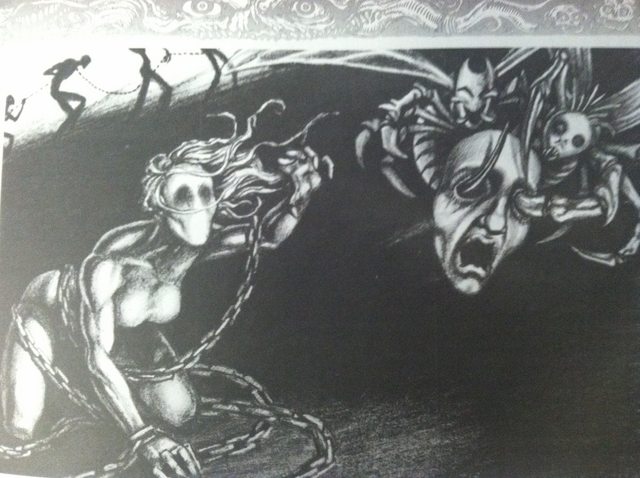
This is what the Far Shores are like now. You can click to make it bigger if you want. This picture caused me a lot of horror when I first got the book, and it still freaks me out a bit.
The Time of Discordance
All this betrayal at once led to a great deal of mistrust, and more wraiths rebelled thanks to it. No one wanted to go outside the city, and soul-trade all but died. This led to three Abominations.
The first was in the early 1500s, when Renegades attacked the walls of Stygia en masse . The Renegades were able to raid the Onyx Tower and get a number of Artifacts, including the Spear of Longinus. The second was the Breaking of the Guilds, on April 6, 1598 (I have no idea what they picked a specific date). A lot guild members died, including Nhudri’s first three apprentices. The final was when the New World was discovered. Charon sent some over to check it out; the Heretics and Renegades found out about it too. They lost to their shadows and slayed the new Death Kingdom they found--pretty much the entire group was destroyed an entire civilization. Sounds familiar.
With the final Abomination, the Third Maelstrom came along. It came all over the Shadowlands at once, separating Stygia from the rest of the Shadowlands. A Spectre named Coldheart led divisions of the infernal with him, and the choked the old River of Death so that the remaining Ferrymen could no longer use it. The Shroud grew bigger and wraiths could no longer cross easily, if they could manage at all.
The Last Three Hundred Years
When the Enlightenment happened, it trickled over to the Shadowlands. Charon finally started to do stuff again; freewraiths could carry swords to protect themselves, and cleaned up the restless would just wandered with little Passion. Machinery began to be manufactured, and those who were no longer able to work or became Passionless were given to the forges to keep them from Oblivion.
Since Stygia was no longer connected to the rest of the Shadowlands, many of the roads and bridges destroyed by the Third Maelstrom, Charon started looking into founding cities outside of it. The first was in London. The success of it led to more.
As the Industrial Revolution hit, gaining coaches, rails, and ships of iron. People began forsaking the faiths of before, and often this led to Passionless wraiths who had nothing to focus on.
The Shroud kept thickening through all this. Charon would try to get wraiths who had ties to the Quick that let them have portals back. Eventually he started to fade away, and he returned to Stygia immediately. He didn’t tell anyone about what had happened, but he did have people start investigating what was happening. It turned out that Charon’s fetters--a lot of the Deathlords and Legionnaires--had been destroyed. Everyone started fighting, and Charon, sick of this shit, retired again. Without Charon, the Deathlords just squabbled and things began to decay again.
Then, the first World War happened, and the Shadowlands were filled with soldiers, scarred by how they had died. Hundreds of thousands of souls streamed and Stygia could not hold them all. When peace finally arrived in the Skinlands, the Fourth Maelstrom swept through; the city managed to survive again.
The new Necropoli did not fare so well, and Spectres broke through the Shroud into the cities they were next to, skinriding and fighting each other in the mortal realm. They glorified in the despair caused by the Depression. Charon stopped moping long enough to place a bounty on Spectres. Supposedly the Spectres helped cause the death of the czars in Russia, slaughter in Spain, and despair in Germany.
Hitler rose to power and again more people died and the second world war happened. Charon decided to fight the Jade Emperor (one of the other Kingdoms) and there were oodles of cool sea battles between them. This went on for years, paralleling the second World War. (The whole reason I’m covering Wraith is to cover the supplement on the second world war. Hold off on major discussion of it for now, please.)
Then the two atomic bombs were dropped. When they hit, it pierced the Shroud and flames illuminated the skies of the Empire for a moment for a split second before the Labyrinth split and screamed, releasing the Fifth Maelstrom .
This was the worst Maelstrom, and it was filled with heat, destroying and sucking everything caught in it straight to Oblivion. Thousands of lesser Maelstroms broke out after it, and travel become virtually impossible. It also released an ancient Maelfean, named Gorool. It was huge, and all the ships that tried to fight it were destroyed. It was going to devour Stygia, and he tried to urge Stygia and the Deathlords to help. No one would help.
Charon left without them. He put on his Mask, picked up his scythe, and went out in his original tiny reed boat. He attacked Gorool, drawing it away from the city he’d pretty much spent his entire existence creating and defending, opening a whirlpool in the middle of the Stormless Sea. He made his Third Descent, taking him, his boat, and Gorool down into the whirlpool. It closed behind him, and Charon hasn’t been seen ever since.
Our narrator from before closes with an epilogue, bemoaning the loss of Charon, the increase in unhappiness and corruption, and wondering what hope there could possibly be. He cautions against mourning too much, and doing nothing else, though, since that will take you to Oblivion.
quote:
Here I cannot be silent, Readers. Hear me swear to you, as you go through this world, do not forget hope. Feed it, nourish it, conjoin with one another and encourage it, make it a powerful, lively thing. Do not forget the words of Charon, or the Lady of Fate, who have promised for us the path to eternal peace. I charge thee all, be faithful to the great goal, and there shall we all find Transcendence.
By Charon’s Oar,
Dante Aligheri
Next time: Rules
Some Basic Rules & Character Guidelines
Original SA postDivineCoffeeBinge posted:
(If your first thought is "that sounds an awful lot like a despotic ruler centralizing the military power of his realm under his direct control so that none may challenge him and his cult of personality," Pendragon may not be the game for you. Even though you're completely correct. We're supposed to ignore that kind of thing on account of how Arthur is a Good Guy, but seriously, sometimes he reminds me of a supervillain.)
This got an honest chuckle out of me; I hadn't thought it but it's pretty true.
---
It's time for some kind of boring mechanics!

Wraith: The Oblivion
Chapters 3 & 4: Some Basic Rules & Character Guidelines
This chapter is incredibly short, and covers the basic rules that most every system of oWoD used. It’s almost entirely their terminology for things and examples of how the system works. It does have some solid beginner advice, like
”Wraith” posted:
The most important rule of Wraith is what we call the Golden Rule. It can be summed up as follows: If you don’t like it, don’t use it. The most important part of the game is the story. As a wise man once said, all the rest is commentary. Feel free to use ignore, or add commentary to your heart’s content; after all, it’s your story.
Which is why I never bothered with all the metaplot for some of the oWoD games. I’m looking at you vampire-werewolf-wizard dude. I’m glad you got horribly killed in the end times.
Anyway, there’s different time meanings, which are stuff like turns and scenes; it has downtime, so you don’t necessarily need to roleplay a character resting if you don’t want to.
Wraith uses a d10 system; for each dot in a trait, you get 1d10. Successes are for when you match or exceed a difficulty number, between 2 and 10. Harder tasks make for harder difficulties. The stupid bit is how you can use modifiers to add or subtract from the difficulty or to add/subtract dice. The more dice over the success, the better the success. One of these is not like the other, and it can make it so you can be very good at something and fumble about worse than someone with only two dice to rub together. This is one of those things that they changed in nWoD.
Actions are things you do. Most the time they’re automatic unless it’s something that requires skill. Traits are scaled from no dots (X) to five (*****). You generally combine an Attribute with an Ability when making rolls. A few have permanent and temporary ratings (like Willpower).
Difficulties are just what number to set it at, ranging from 3-9. Degrees of success are defined from 1-5. All 10s rolled are automatic successes. Rolling a 1 is a ‘botch’ and immediately cancels out a success. If you have more 1s than successes, then you critically fail what you were doing. You are allowed to try again after failure, with difficulty increasing by one--Storyteller’s choice. If you’re rushed, for example, and screw up picking a lock, then you’ll have a harder time since you’re under more pressure. Other than, if you’re researching something, you probably won’t be as rushed.
And that’s it for chapter 3. Turns out they hide the huge lexicon of words for here. You guys know all of these by now since I’ve been discussing them.
Let’s go straight into Chapter 4, which is also fairly short and describes character creation. It recommends you start with a concept, that culture and race don’t really matter, and how it’s a point buy system so you get a character you like.
”Wraith” posted:
It’s a very good idea to sit down with your fellow players and make sure that all of your characters are compatible with each other.
I wish more people said stuff like this.
 In any case, for a game like Wraith, it helps, since you can tweak if you guys share the same Haunt, or maybe a Fetter, how you might have met if you share beliefs. The book emphasises you don’t have to all be exactly the same or whatever, but that having ways you all sort of hook up is helpful--which it is.
In any case, for a game like Wraith, it helps, since you can tweak if you guys share the same Haunt, or maybe a Fetter, how you might have met if you share beliefs. The book emphasises you don’t have to all be exactly the same or whatever, but that having ways you all sort of hook up is helpful--which it is.
Oh, and some Storyteller advice:
”Wraith” posted:
Part of your job will be making sure that all characters fit your planned chronicle. A katana-wielding samurai from the Jade Empire might make a sensation character, but if the rest of your players have decided to play no-nonsense Legionnaires, your samurai is going to feel distinctly out of place. At the same time, you should make sure that one character won’t be able to bully the others into doing what he wants by virtue of his statistics.... Making sure everyone is on more or less equal footing is vital, otherwise the imbalance will quickly wreck your whole chronicle.
That’s right Storytellers. WW telling you Just Say No to poor character creation.
Anyway, creation breaks down into a couple of steps. First is concept, which is where you figure out the basics. Who are you, how did you die, and why are you a wraith? It lists a few different answers to all of these. Next you pick the personality archetypes which best suit your view of the world, and also who you present yourself. They don’t have to be the same. There’s a list of a bunch of different one word summaries.
The second step is picking what attributes are dominant and which lag. You arrange Physical, Social, and Mental, and this is going to let you know how many points you get for each. Everyone gets a default dot in all of these. Step three is abilities. Abilities are similarly organized in order of how you would like them, with points awarded based off that order. You can’t put more than 3 dots in one Ability during chargen unless you use freebies at the end. Fourth are advantages are things like your Arcanoi, Backgrounds, Fetters, and Passions--these all get a set number of points.
Finally, you finish off with details. This is where you detail them, figure out their Pathos, Willpower, appearance, and all that. This is also where you spend your freebies, and it tells you how much you have to spend to raise certain things. And that’s it for chargen.
It’s recommended that the Storyteller run through a Prelude with a character. This usually covers their last bit of life, the death, and what it’s like when they are reborn, and are usually one-on-one sessions. This lets a player interact with a lot of those Fetters or Passions and leaves them unfinished after they die.
The final section are just some good questions that could help define your character. Stuff like how old you were, what you do for fun, how you reaped, how you met your Circle--things that generally help you create a more realize person.
Next time : We begin to cover all the traits that will make up your character. This is another large chapter, and spans everything from Attributes to Arcanoi. I’m going to go from the beginning up to Arcanoi, and then cover the Arcanoi all at once the next next time.
Everything but Arcanoi
Original SA post
Great news! In the core book of Wraith, we get mostly useful and interesting skills and backgrounds and merits don't even exist. We'll see if that maintains when I look through the Player's guide tonight to check out the other guilds; it'll be the first time I've looked through it. This thread twisted my arm, and now I have a bunch more Wraith books to browse through and figure if any others are worth covering. (At least it doesn't have as many as 7th Sea)
The nice thing with oWoD is you could buy one book and be set. I think you can still do that with nWoD if you want.
It's Friday and work is being incredibly slow. Have another update!

Wraith: The Oblivion
Chapter 5, Part 1: Everything but Arcanoi
This chapter is all about the traits that make up your character. You can follow along with your very own character sheet if you want:
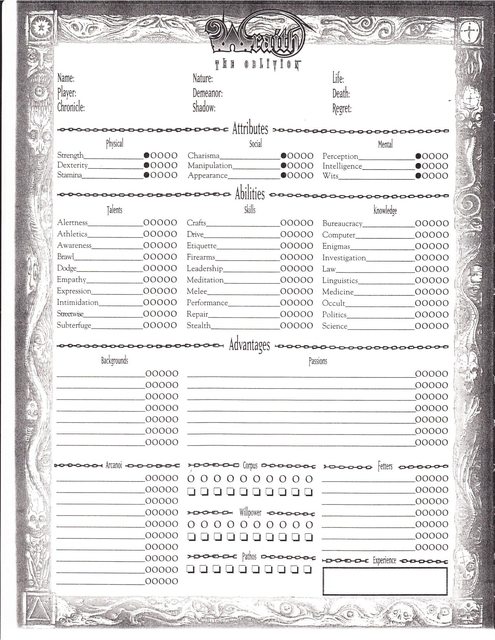
Click to make bigger. Yes, there’s a separate sheet for the Shadow
Specialties are what those blank lines next to Attributes and Abilities are for--you can pick one if you get 4 dots. It gives you an opportunity to re-roll all 10s to try for more successes.
Archetypes
are a rough personality type. One is Nature, which best represents what the wraith actually is, while Demeanor is how she presents herself to other beings. Acting according to Nature earns you Willpower back, which is pretty important. There are separate Archetypes for the Shadow, and we’ll cover that in Chapter 6, which is all about Shadows.
Some sample Archetypes (you can make your own with Storyteller approval):
-
Architect-- You like building things and get willpower for things coming to fruition.
-
Bon Vivant -- Party animal, willpower from having an unadulterated good time.
-
Caregiver -- Babysitter. Willpower when you have tangible proof you helped another.
-
Martyr -- Always sacrificing self for a cause. Willpower when you do so.
- Traditionalist-- The past is the one true answer! Willpower when tried-and-true is effective, especially against Oblivion
and so forth. The book lists about 21 different archetypes, and I guess if you guys really want I can sum up all of them.
Attributes are the raw talents of your character. They are separated into physical, mental, and social; you can order them however you like. Top pick gets 7 points, second 5 points, and last 3 points. They all list what different point values mean. Some are kind of funny.
The Physical attributes are:
-
Strength--Physical ability to change the world around. This is used for brawny things as well as jumps, leaps, and stuff that needs physical power. This is used for base in physical attacks. (This does not involve you affecting the Skinlands).
-
Dexterity--Fine and large motor skills. Speed, manipulating small items, and so forth. It’s base for whether you hit or not in combat, and for ranged.
- Stamina--This is how well your Corpus stays together under assault. It’s base for how many dice you get to soak damage. Also, 5 dots is great: You survived being given enough poison to kill an elephant, being shot three times, getting stabbed over 10 times, beaten by at least five people, tied up, placed in a sack, and dumped in a freezing river.
The Social attributes are:
-
Charisma--Your presence to other wraiths. It’s how well you attract others who want to willingly spend time with you.
-
Manipulation--How well you can bring people over without them noticing. This can bite you in the ass since people are generally more opposed to being manipulated than charmed.
- Appearance--What it says on the tin, though it also affects how well you leave an impression on others. My favourite one of these is 4 dots: One of the “25 Most Beautiful Wraiths of the Year.” Probably cause I like the idea of a ‘People’ magazine for wraiths.
Mental attributes:
-
Perception--Is how well you notice the world and the details around you.
-
Intelligence--Sum of your knowledge and how well you can reach new ideas. It’s how well you think instead of how fast. If you have one dot you apparently have trouble counting to 10.
- Wits--Your ability to react to information. It’s how fast you process things and thinking on your feet.
There are a lot more Abilities , but that makes sense. These are things you picked up in life or unlife, and if you don’t know how to do something you might not be able to even try depending on what you are doing. Again, order them based off what you like. Top pick is 13
points, second is 9, and third is 5 points.
We’re going to try and do a quick run-down on all of these.
Talents are things that are intuitive. You can try to roll for any of these without a penalty since everyone has a sort of idea how they work.
-
Alertness--Awareness of physical surroundings, covering all five senses.
-
Athletics--General physical fitness and skill at using the body in ways other than combat. This is for tree-climbing and so on--it has to be a complex physical action.
-
Awareness--Spooooky awareness; how alert you are to when things are out of place or when something weird is about to happen.
-
Brawl--How well you hit someone; covers all unarmed combat.
-
Dodge--How well you get out of the way.
-
Empathy--Noticing others emotions and understanding what they feel. This doesn’t make you sympathetic necessarily. 5 dots lead to your psychiatrist telling you about his problems.
-
Expression--Getting the point across concisely and clearly; can make you memorable even if your charisma sucks.
-
Intimidation--Coercing others to your will. 4 dots gives you the power to get writers to meet deadlines; seems pretty impressive to me.
-
Streetwise--exactly that. How well you know who has what on the streets, and how to fit in.
- Subterfuge--Bending, twisting, or breaking the truth and getting away with it. Also lets you sense when others are doing that.
Skills are things that you might know about but also need some training with. You can still make an attempt at a +1 difficulty since you have no clue what you’re doing.
-
Crafts--Making useful things, you can pick a specific craft too if you want. Success indicates quality of item.
-
Drive--This is for tricky maneuvers, since everyone modern is assumed some familiarity with driving. (Thanks for alienating me WW
 I don’t drive at all(ok I know how to drive and can do so if needed)) This can also be for specific vehicles as a speciality or types of terrain.
I don’t drive at all(ok I know how to drive and can do so if needed)) This can also be for specific vehicles as a speciality or types of terrain.
-
Etiquette--Your understanding of polite society in different social circumstances.
-
Firearms--How well you can shoot and your skill at maintaining them. You probably won’t see much use of this in a typical Wraith game; bows/arrows and such are a different skill.
-
Leadership--Getting others to obey and how well you do at that.
-
Meditation--Pretty important since your Shadow is a jerk. You use it to center yourself, and it can let you catch up on lost Slumber.
-
Melee--All that stuff with weapons in fighting up close that brawl doesn’t cover. You can pick a weapon.
-
Performance--How well you perform a chosen talent as well as the knowing the society involved in it.
-
Repair--Restoring items of all types. This is used for those who Gremlinize things or where best to hurt them with Outrage, as well as fixing stuff.
- Stealth--Sneaky. Roll against someone else’s Perception.
Knowledges that require actual study to know about. If you don’t know something a specific field, you cannot try to roll for it. Exceptions are for trivial stuff most wraiths know--like what a Legionnaire is--or very special circumstances.
-
Bureacracy--You can work the system to get what you need and get stuff done.
-
Computer--How good you are with computers. This is showing it’s age a littele with “In a world where the operation of basic word processing software is still a mystery to many adults....” Wraiths can use this to actually enter electronics and manipulate the info in them.
-
Enigmas--Puzzles and mysteries! How well you solve those things too.
-
Investigation--Criminology and forensic analysis.
-
Law--The legal system and how it works.
-
Linguistics--This is how many languages you know besides your base, and can also be used in identifying accents, picking up slang, and mimicry.
-
Medicine--Repairing the human body, and how to hurt it too. If your Fetter is living this can pretty useful, since you can generally use it with Deathsight to see what might endanger them.
-
Occult--How much you know about the supernatural in WoD. 4 dots is like you get to read all the books.
-
Politics--Figuring out who’s on top and how they got there.
- Science--Theoretical and practical knowledge. High levels usually require specializtion.
All of the Abilities have a generic slot for Additional Knowledges, so if you want to crossbows, you can pick that up in Skills; Theology would be a Knowledge, and so forth.
Backgrounds are things that give context to your character. These help define the character and give people who meet her a little context. Storyteller’s get veto rights if your Background doesn’t fit; if you just died you probably don’t have Mentor, though you can acquire one as the story goes on. Some, on the other hand, might require a certain Background, which a Storyteller might grant as freebies. In any case, you 7 points to spend on these.
-
Allies--These don’t have to be close friends, and they won’t be circle members, but they are usually like-minded people or anyone who feels kinship with your character. They give aid, and they need to be maintained; occasionally they in turn will call upon you. Having no allies is a little unusual.
-
Artifact--These are usually Pathos fueled, and they aid those that carry them. You need a good reason to justify how you got it and why you get to keep it.
-
Contacts--These guys won’t necessarily aid you if you need it, but they will work for you. Major contacts are those that will cut a deal and recognize the character; minor are usually less informed, less helpful, and less friendly.
-
Eidolon--This is your spiritual fortitude. This represents how able to resist the manipulation of the Shadow you are (note: does not equal a good person). Usually ranks in this allow for a special ability in staving the shadow off. This allows you to roll one extra die per session to resist your Shadow at some point.
-
Haunt--This is whether or not you have one. These can be shared among groups. They also gather Memoriam (we have not talked about this yet) which a wraith can gather. Players can combine this to have a shared haunt, or buy it twice for one communal and one private haunt.
-
Legacy--What did you leave behind? These are your works that live on after you, and it allows you to try and gain some comfort from it once per story (a set of sessions that forms an entire beginning, middle, and end). This lets you heal damage.
-
Mentor--A teacher, patron, protector, or all these. They won’t always help, they do try to act in your best interests (even if you don’t think they are...) Usually there are responsibilities on both sides with this. The Mentor picks what to teach you.
-
Memoriam--This is how many people remember you. It doesn’t matter if it’s good or bad; Hitler would have five ranks of this easily (legendary status for an entire nation or more). It lets you access extra Pathos, and you can invoke it once per session. If you botch this, you permanently lose one point.
-
Notoriety--This is your reputation in the Shadowlands. How well you are known, talked about, and what preconceptions people have. It doesn’t matter how famous or not you were alive.
-
Relic--Things you brought with you. It doesn’t necessarily need to be yours, but it probably is. Purchase buys one relic, and you can buy multiple times for more than one. Level shows how complex it is.
-
Status--Concrete recognition of power. If you want this in multiple groups you need to buy it multiple times. High status usually leads to more responsibilities and looking after other wraiths.
Fetters and Passions aren’t covered in-depth here apparently; the Storyteller’s chapter mentions how to help people create them. I’m going to go over how you pick them out and set them up here, as the sky is pretty much the limit. Generally, you pick things that show stuff about your wraith.
Fetters can be your ex-lover, a garden you particularly loved, and usually you should have these very described. They are physical objects. You get 10 points to split among your Fetters, which will go up and down depending on the state of them. In general, it is much harder to get these up than down during course of play, but you can spend experience on them. If a story deals directly with one of your Fetters (like protecting it) you’re much more likely to be able to bring it up.
Passions are things that you are passionate about.It’s what fuels your existence. It can be revenge (“Find and kill the one who took my job and made me kill myself”), confusion (“How did I die?”), and so on. It’s made up of a core emotion (love, vengence, hate, ect), and a statement. These will be much more involved, and you’ll likely know more, but that’s what’s going to show on your sheet. You get 10 points to split among these. Generally they go up when you get closer to achieving a victory and go down when you feel like you’ve slipped backwards.
Generally, more important Passions and Fetters get more points, and incidental ones get less. You are probably much more willing to strive for your pet passion than something sideline.
Corpus is both your body and your essence in Wraith. Part of what is so horrifying about Moliate and forging to me is that they are literally manipulating and destroying your soul to make these items, and it’s also body horror. It will look most like your subconscious image of yourself; you can look utterly inhuman if you want and you probably won’t stick out too much. Most of these features are purely cosmetic. Wardrobe will often change without thought to suit the situation, since it’s just drawn from your corpus. Permanent corpus is the maximum number of levels you can have. You get to start at 10, but this can go down if you fail or botch Harrowings (we will get to these delights later). This means you lose all temporary Corpus more easily, making it more likely you’ll go into another Harrowing, and repeat. Oblivion is pretty vicious, and there’s no known way to increase it again--but there are rumours that it’s possible.
Temporary Corpus are the circles, and it can never exceed permanent. This goes up and down all the time, either with Pathos or Slumbering to heal, and down with interacting with the Skinlands or violence in the Underworld. No matter how severe Skinland impact (it needs to generally be violent, like a car driving through) you only lose one point. You go incorporeal and can’t be damaged for turns equal to Stamina. Underworld violence works like other oWoD settings and involves soaking, aggravated, and so forth.
The last things you need to know and which aren’t discussed here is that you get a beginning Pathos of 5 + Memoriam background and your Willpower will start at 5. You can buy more of these if you wish. Freebie buy happens after all other point buys (including Arcanoi, which we cover next time), and you get 15 points. You have to buy them according to how they would be at ‘level up’.
-
Attributes--5 points per dot
-
Arcanoi--5 points per dot
-
Basic Arcanoi Abilities--3 dots per Arcanos
-
Willpower--2 points per dot
-
Abilities--2 points per dot
-
Passions--2 points per dot
-
Backgrounds--1 point per dot
-
Fetters--1 point per dot
- Pathos--1 point per 2 dots
Arcanoi basic abilities are things that aren’t as good as the 1 dot Arcanoi but does give you some knowledge and so can make it easier to get the regular levels later.
You can also spend freebies to help weaken your Shadow’s pool on a 1:1 basis, or give 7 extra Freebies to the Shadow.
And that about covers all the stuff on the character sheet so far. Whew.
Next time: Arcanoi!!! Crappy photos of the art for everyone! A quick cameo from the Player’s guide for the three banned guilds (maybe)!
Arcanoi are the best way to implement ‘tribes’ ever and totally doesn’t involve stupid ‘stereotypical’ thoughts on everyone else or whose drawn to it. Probably my favourite structuring of powers in the oWoD line.
Edit: fuck lists and submit != preview
Ghost Powers (aka Arcanoi)
Original SA post I love Planescape.
I love Planescape.
Also, turns out I shall do Arcanoi in two posts.

Wraith: The Oblivion
Chapter 5, part 2: Ghost Powers!
 (aka Arcanoi)
(aka Arcanoi)
Unlike every other oWoD game, you can have access to any of these powers. You don’t have to be part of a certain club or faction, you don’t have to have died a certain way, you don’t need to be born under the right moon or into the right tribe. You can literally mix and match these however you want, and that’s pretty damn fine.
For any of these, there are alternate versions you can pick up instead. If you ever want to learn the base one listed in the book, you have to relearn it with the same point cost. To learn alternates you have to have at least one level in that Arcanos already.
Since people are constantly changing, as are the different things people believe, Arcanos can manifest differently for two different wraiths.
Using a particular Arcanos a lot will mark a wraith permanently--you don’t have to be associated with the Guild either. If you learn multiple, it’s possible that you’ll be marked by multiple. The strongest one will predominate, but others will leave some mark as well.
Mechanics: you use the Arcanos rating with an attribute. You spend Pathos to activate it; whether you succeed or fail all required costs must be paid. Environment can affect use as well. Shroud rating for an area can often cause difficulties for many Arcanoi. There are more detailed rules for Shroud and Shroud rating later on in chapter seven. Fetters can tie into difficulty as well, and needs to be involved with the roll somehow.
Botching an Arcanos roll usually means bad stuff--if, for instance, you botch a shape-changing roll, it’s possibly you can’t change form for the rest of the scene. We’ll have some descriptions of possible botches with each Arcanos.
Attunement is gradually practicing an Arcanos on a single subject, using Willpower so that future working with that subject will be easier. These are usually used with powers that involve the Skinlands.
There are three arts that are not part of the main book, and they were banned or in very low use in the Shadowlands. I’ll browse the Player’s Handbook and see if it’s worth covering the whole thing; if not I’ll just do a mini-update with those three separately.
So I found all the guild symbols online, so good quality pictures for those. Not so good for the character portraits. Sorry guys. Now, let’s get to the main attraction!
Argos: The Harbingers
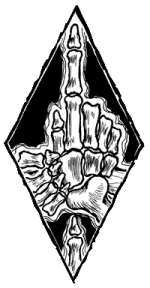
”Harbinger” posted:
Hear that? That howling behind the shadows in the alley and under the concrete skin of the city lots.... Hear it? Take my hand, and hold tight. That’s where I’m taking you....
This is the Arcanos of traveling through the Tempest. It lets you travel safely, going between the safe spots. Masters can go nearly anywhere without getting in trouble. No Argos makes it impossible to change direction in the Tempest without spending a point of Pathos, and you have to have it to even have a good chance of finding a Byway. They can take passengers by making hand chains, though it might increase the difficulty.
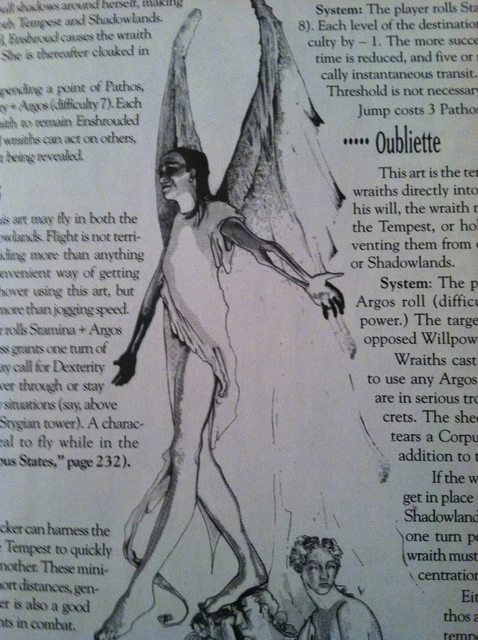
Guild The Guild itself was a loose collection of messengers, heralds, and explorers. They were your friendly Coast Guard. They dropped out of the Revolt pretty fast, because they didn’t really want to join in the first place. No one really gives them shit about it, and they pretty much kept on afterwards, though on a more individual basis. They pretty respected, but they will always stop to help stranded wraiths in the Tempest.
This will gradually stain a wraith’s eyes jet black.
Botches can cause you to get stranded in the Tempest. It’s also possible to hallucinate and see things that aren’t actually there or missing things that are. Botching this usually puts you in danger.
Basic Abilities
-
Orienteering: THis lets you determine location in the Tempest and where the destination is. This is useful in emergency situations; you wouldn’t use just this to travel the Tempest. Moving without shortcuts will use normal walking/driving speed.
-
Tempestpeek: This lets you look at the Tempest and notice anything nearby; it also allows for communication with these things.
-
Tempest Threshold: The ability to open your own portals into the Tempest instead of using a Nihil. These are small and close immediately after passing through.
Main Powers
-
One Dot: Enshroud -- Ability to hide yourself from unfriendly eyes. It makes you suddenly vanish. You can even punch people and you still won’t be revealed.
-
Two Dots: Phantom Wings -- The ability to fly! It’s really more like gliding, but it does let you get around a bit more conveniently.
-
Three Dots: Flicker -- You can use the Tempest’s natural wonky geography to do mini-jumps between places. Usually only good for line-of-sight, but man, you can be Nightcrawler! And yes, you can use it to blindside opponents. Botching is bad though and gets you stranded in the Tempest.
-
Four Dots: Jump -- You can travel to any of your Fetters, line of sight or not. Only works for your Fetters though.
- Five Dots: Oubliette -- You can punch people who piss you off directly into the Tempest. You can also use it to pin them inside the Tempest too.
Castigate: The Pardoners
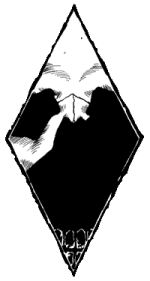
”Pardoner” posted:
You’re never alone. Never. Not while the Shadow squats on your back. I can help you. I can hurt it. For a price, yes, but I take far less than it would.
These are the people that make fighting the Shadow a little easier. For whatever reason, these wraiths have a talent for helping to suppress or hurt the Shadow. It’s one of the really personal Arcanoi, with everyone having their own methodology--psychology, meditation, sermons, you name it, someone probably does it. A lot favour a dialogue based on the target Shadow, called the Devil’s Dialectic. It’s not all roses though--this is pretty dangerous stuff, so WW (rightfully, I think) encourages coming down on fuck ups and slight errors pretty hard. All of these powers will make a user’s Shadow stronger (increase Angst).
A quick work on Angst: Permanent is how strong your shadow is, and is generated at character creation. Higher permanent Angst means your Shadow is stronger and can do stronger things as such. Temporary angst can, unlike every other temporary, rise above permanent--10 can be traded in for 1 permanent. You are very unlikely to know exactly how much or where your Shadow is on this scale after cargen, if you even knew at chargen. That’s part of what makes this Arcanos a big gamble.
It makes your fingers turn inky from dealing so often with other’s dark sides.
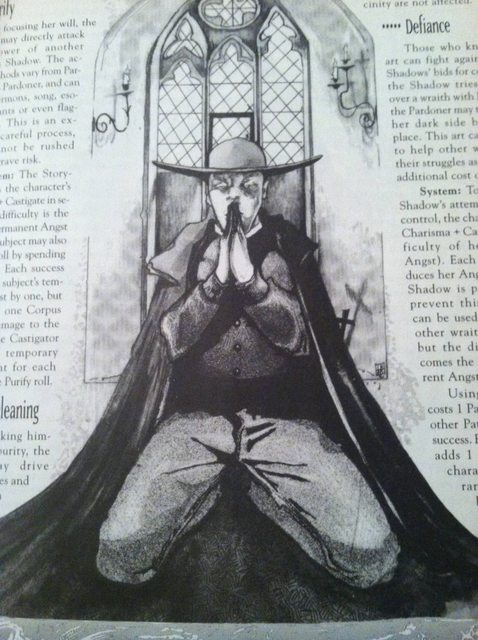
Guild In the heyday before the Revolt these guys were pretty zealous and almost an Heretic cult themselves. They joined because they disliked the harsh treatment of Heretics, and Charon mostly just slapped them on the wrist for it. No one will arrest a Pardoner for hanging out her iron lantern because their services are considered so vital. Older members tend to describe it religiously; new blood tends to prefer science and psychology.
Botches
A Shadow can gain temporary Angst (basically it’s power level) or let its next ride be that much stronger. All botches will piss the target Shadow off, which is bad news the next time it can push its wraith.
Basic Abilities
-
Bulwark-- You can briefly guard yourself and companions from a Maelstrom (remember, there are smaller ones all the time). It also keeps them safe from passing Spectres.
- Soulsight -- You can examine and see another’s Shadow. Careful study allows for a rough estimate of angst and how close it is to the surface. It can notice Spectres as well. You can’t use this on yourself.
Main Powers
-
One Dot: Coax -- It allows for some power over your own Shadow. You can call upon it’s powers with much less risk. It makes the Shadow stronger each time you do this.
-
Two Dots: Dark Secrets --You can learn someone else’s skeletons in the cupboard by studying their Shadow. Shadows can lie though; weak Shadows will generally have to tell the truth, but nothing really stops a strong one. It will make your Shadow stronger when you use this.
-
Three Dots: Purify -- You can directly attack another wraith’s Shadow. This takes a long period of time, and rushing will dramatically increase the risk. Everyone one rolled for this will add one point of temporary angst to your shadow.
-
Four Dots: Housecleaning -- “By cloaking himself in his purity, the wraith may drive away Spectres and keep them from entering his immediate area.” You can use this for buildings, within reason. It won’t, however, keep Doppelgangers away.
- Five Dots: Defiance -- You can beat your Shadow back whenever it tries to take control of you. You can help others with their struggle at the cost of 1 Angst--difficulty goes up by 3 though. Failing will add 1 point of temporary Angst to you; botch adds 1 permanent Angst.
Embody: The Proctors
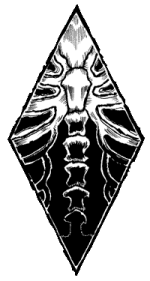
”Proctor” posted:
Open yourself to the warmth. Forget the Shadowlands, forget your Corpus, forget even me. Just concentrate on the warmth -- it should bake you like sunlight used to. Remember? Remember sunny days in the park and loose cotton clothes? That’s it....
This is the art of physically manifesting in the world. It’s pretty expressly forbidden by Charon’s Code. Most wraiths who do it are able to do so by focusing on one particular sense. Embodying will open you up to injury in the Skinlands; ‘dying’ will cause you to immediately get thrown into a Targeted Harrowing as the Quarry (that’s pretty bad, by the way).
It’s very helpful to Attune to a particular person. It makes it easier to Embody to that person, and no Pathos cost. Only the person would see them though. Difficulty otherwise is Shroud rating.
Your skin will have different patches of light and dark, similar to how light dapples on through trees.
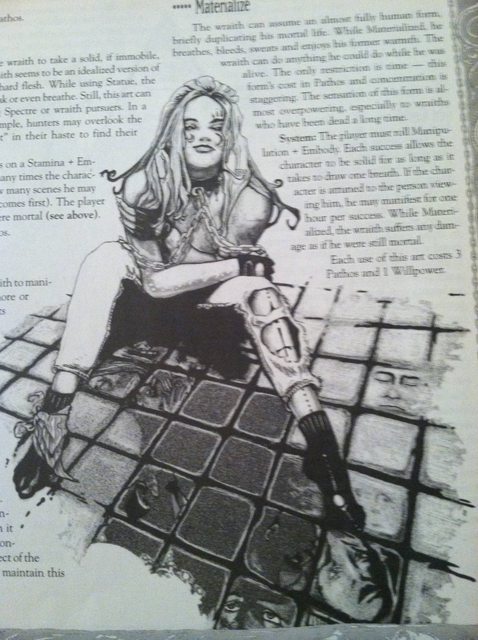
Guild They were always on pretty poor terms with the Hierarchy, most thanks to Charon’s Code. They were employed, but would still jump over when they could. They were very gung-ho for the Revolt, and were blamed for a while after it failed to the point they were hunted down and forced into Thralldom. It’s eased a little since Charon went and fought off Gorool, but it’s not a good idea to flaunt your talents in Hierarchy territory.
Botches
Weird things like losing your voice in the Shadowlands or falling into the Tempest instead of embodying. You can also gain Angst because you get a brief taste before it’s snatched away violently if you fail.
Basic Abilities
-
Ghostly Touch -- You can reach out across the material world; you won’t be able to move anything larger than dust. You can write on a fogged window, and that’s with loads of concentration.
- Maintain the Material Form -- This lets you maintain Embodiment for longer periods of time.
Main Powers
-
One Dot: Whispers -- You can whisper across the Shroud, being heard in the Skinlands. Good for driving people crazy.
-
Two Dots: Phantom -- You can become a hazy, translucent being; you don’t look much like your mortal body. You can use this to scare people if you like; most people will react automatically with fear anyway.
-
Three Dots: Statue -- You can take solid but immobile form. You have no ability to move, speak, or breathe. It’s good for hiding from pursuers if you go somewhere crowded though.
-
Four Dots: Life-in-Death: You manifest more or less as your mortal form. Flesh will be colder than it should be and you’ll always look distracted due to concentrating to maintain the form. You also won’t look enough like yourself to fool those who knew you very well.
- Five Dots: Materialize -- You can assume an entirely mortal form; you will bleed, sweat, and be warm. You can do anything that the living can do, but you’ll be draining your Pathos incredibly fast.
Fatalism: The Oracles
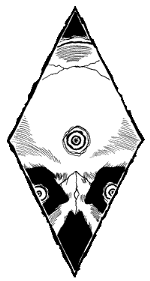
”Oracle” posted:
Ah! Forgive me, my lady, for I did not recognize you. Of course I shall advise you. No, there is no cost; all I ask in return is that you remember me when your time comes.
This allows you to read Fate, to interpret the past or future. This is actually a pretty dangerous Arcanos as well, because often those who meddle with it find themselves unable to get away easily, and often wind up paying for it. (aka don’t piss off your Storyteller, natch?)
Most are very gaudily dressed, though not necessarily. They all gain markings or symbols of Fate through repeated use of the Arcanos and they cannot remove them; many move or shimmer on their own.
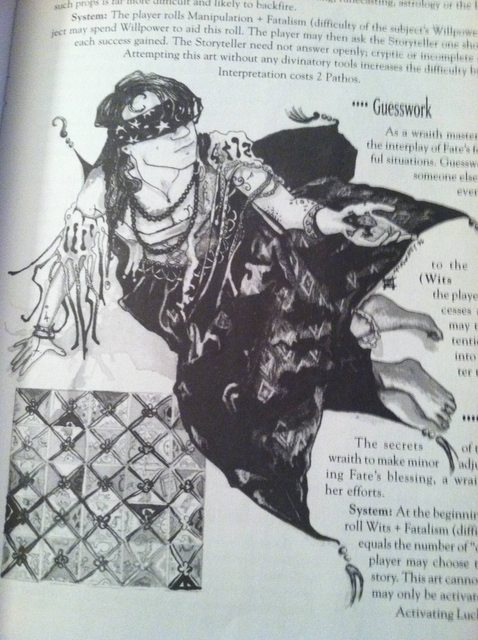
Guild These guys were pretty popular pre-Revolt, and it was rumoured they served the Lady of Fate herself. They were good advisors and counselors. Then their head Oracle told Charon that he was gonna get lost to the Tempest--he threw a temper tantrum before she could finish her prophecy, and hurt her pretty badly. Thus why the Oracles went in on the Revolt; they pulled out though when the first two backed out, even knowing it wouldn’t be good in the long run.
They don’t openly advertise, and usually just leave clues for the clever to seek them out. They are still pretty tight with other guild mates, though they try not to hang out too long together.
Botches
Most the time it’s misinformation. Of course, it could be worse--some will see something bad coming or they won’t be able to concentrate for a few scenes (add difficulty to all rolls). Or worse, their Arcanos might not respond for a while if they fuck up.
Basic Abilities
- Kismet -- The ability to figure out how important someone is in the grand scheme of things.
Main Powers
-
One Dot: Fatal Vision -- You can read deathmarks on wraiths and on mortals that will die soon. Particularly tragic deaths usually manifest months or years in advance. This will also reveal if they’ve been previously targeted by the Arcanos, though not necessarily why or for what.
-
Two Dots: Foreshadow -- You can perceive when danger is drawing closer. The uneasiness of success will cause 1 angst.
-
Three Dots: Interpretation -- You can read a person’s fate or past. Usually you use some sort of prop, like Tarot or I-ching. No props will raise difficulty.
-
Four Dots: Guesswork -- You can read into someone else’s actions, and intuitively respond before they act; it’s basically seeing into the future very short term.
- Five Dots: Luck -- You may make minor adjustments to Fate itself. This allows you to enjoy greater success in your efforts. It basically gives you extra rolls/ignore extra ones.
Inhabit: The Artificers
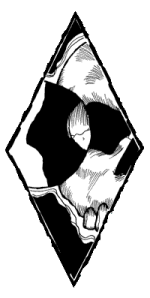
”Artificer” posted:
I used to be a skin sack filled with warm blood, same as you. I just traded up for a better model. Now I have a motor for a heart, electricity in my veins, my hair is fiber-optic, and my copper fingers snake through cities. It’s the ultimate upgrade, my friend. Get with the program.
Every WW game seems to have that one group that’s all about The Future, Maaaan. This is Wraith’s. They can fuse into the inanimate, and can even learn how to animate the item eventually. They can also use it to make their own Artifact out of the item if they want, which is why they are considered important to the Hierarchy. The powers here are relatively new; there are older arts that get described in the guildbook and which aren’t really taught anymore. You can, naturally, attune yourself to a chosen item for easier rolls.
Most have reddish patches or markings from working at the soulforges. Younger ones who specialize with new technology usually have traces of circuitry instead.

Guild These guys claim that Nhudri founded the guild in order to have helpers at his forge. They’re pretty proud, and they were the guys who urged the Revolt. You can still find ex-guild at the forges, but in many places it’s illegal to teach or use the skill. The best Artificers live as far away from the City as possible if it’s the only thing they know.
Botches
This can lead to getting stuck in your item for a bit more than you really wanted or planned. It can also lead to shorting a device you need, deleting important files, and so on. Particularly new items might even explode on a botch.
Basic Abilities
-
Sense Gremlin -- You can figure out if an object is currently inhabited by any wraiths.
- Shellride -- You can hide in an object from other wraiths. You can’t do anything to it, except choose when to leave.
Main Powers
-
One Dot: Surge -- You can cause a temporary short in a device you pass your hand through. It can damage some delicate equipment or things without surge protectors.
-
Two Dots: Ride the Electron Highway -- You can travel along communication networks. It’s basically riding through tunnels of light; getting around security systems can let you go most anywhere. Fucking up gets you angst and a possible stranding somewhere not pleasant.
-
Three Dots: Gremlinize -- You can possess and control machines. Attunement is required for more delicate things.
-
Four Dots: Claim -- You can shellride an object and possess it as your own body for a scene. Your senses are about the same, just spread over the whole object. You can exert some control over the object as well.
- Five Dots: Empower -- This is a cheap one time use Artifact. You put one of your Arcanos inside it, usually an item related to that Arcanos. This can allow someone to use an Arcanos they might not otherwise be able to. You have to empower it a second time after it’s used the first time.
Keening: The Chanteurs
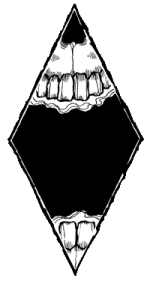
”Chanteur” posted:
Do you think that because we no longer draw breath, our voices lack power? Hush. Hush and listen.
I’ll admit it, I totally played a Chanteur. I love music and sound, so these guys really appealed to me. I had other Arcanoi, but this was my pet one, and I still maintain it’s pretty cool.
This is tapping into the emotions created by sound. Banshees and stuff were probably ghosts with keening. You don’t have to use music to use Keening; you can use dance, oration, laughter, whatever, it just raises the roll by 1 since it’s taught via music. Feelings instilled are artificial, and it restores Pathos very rarely. Usually, master Chanteurs will use it on one person and feed off the energy he causes in others.
All Chanteurs will use some sort of noise maker, whether it’s an instrument, clapper, or whatever, whether they perform a cappella or not.
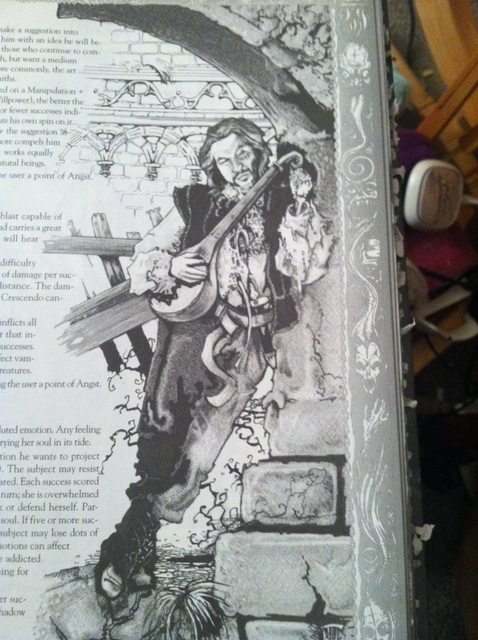
Guild As a guild, they were incredibly proud of their skills, and would hire themselves out as troubadours to the elite. They were pretty excited about the Revolt, and it took a long time for their pride to recover from the loss. Even with the guilds hiding, individuals still often maintain influence in the higher stratums and they are still very popular with many wraiths who want to feel a little human emotion again.
Botches
This often involves emotional feedback or fallout. Angst can be increased, make everyone else’s rolls harder for a scene, or drive the user made for a bit when the emotions are turned back on himself.
Basic Abilities
-
Perfect Pitch -- You can notice when another wraith is actively using Keening.
- Sotto Voce -- You may hide your Keening arts in normal singing or casual conversation.
Main Powers
-
One Dot: Dirge -- You can catalyze a listener’s ‘darker’ emotions: despair, anger, lust, loneliness, grief, so on. This is useful in removing mortals from a particular area. Wraiths aren’t as affected by the skill. It gives a user one temporary Angst.
-
Two Dots: You can inspire ‘higher’ emotions: love, serenity, joy, mirth, ect. This is very useful in protecting your Fetters and swaying other wraiths to alliances. Wraiths aren’t as affected as mortals, as before, but it still makes them feel warm and fuzzy

-
Three Dots: Muse -- You may make a suggestion to a subject’s subconsciousness, inspiring him to an idea he’ll think is his. This is good for those who want to keep composing/creating, but need a mortal to take it over the Shroud. It’s commonly used in the subtle manipulation of other wraiths. It works just as well on wraiths. Also, enjoy a point of Angst! Hope you get five successes, because then they’ll listen to you whether it’s harmful or not.
-
Four Dots: Crescendo -- You can do a musical blast capable of damaging plasm at close range. It carries a long way around too, usually a few miles. If you happen to be Embodied and do this, all listeners will take one health level of damage from pure terror, and it can affect the supernatural too! Another point of Angst for being a jerk.
- Five Dots: Requiem -- The subject is flooded with pure, undiluted emotion. Any feeling at all the you want they will be flooded with. A subject has to be prepared, otherwise they get no roll to save. Dark emotions can fuck a person’s being up-- five or more success will lead to losing dots of Mental Attributes or going insane; pleasant emotions can lead to an addiction to the effect. Dark emotions will add one point of temporary angst.
Lifeweb: The Monitors
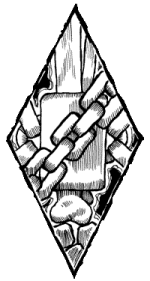
”Monitor” posted:
How did I find you? Love, it was easier than you think. We had a bond in life; in death it’s even stronger.
These guys are the creepers that study the ties between the living and the dead. They can manipulate Fetters and all that, and can even sever them when they are talented. Conversely, they can use it to watch their own. They will even create temporary Fetters so they can watch over stuff more effectively.
They never ever close their eyes, even in Slumber. That’s how most people figure them out.

I will stare into your sooooouuuuul!
Guild They were never a very strong or vital guild like some of the others. They usually trained members as Reapers, and generally weren’t focused on Stygian politics. Since the Revolt, they are even less trusting, and won’t teach anything but remedial Lifeweb skills unless the pupil is proven to be trustworthy. Some rumours say there are ex-guild members who run protection rackets.
Botches
This can be a wide range of things; it can lead to a misreading on an object, losing track of one of your Fetters for the duration of the story. Particularly drastic results are rumoured to lead to severing your own Fetter.
Basic Abilities
- Locate Fetter -- You can check up on any of your Fetter and its surroundings, as well as orient yourself towards it.
Main Powers
-
One Dot: Sense Strand -- You can examine patterns of energy around wraiths and their Fetters. You can figure out if an item is a Fetter and the wraith attached to it.
-
Two Dots: Web Presence -- You can affect your Fetter from any distance away, using any Arcanoi, mental, or social attribute with anything there.
-
Three Dots: Splice Strand -- You can make an attachment to a person, place, or thing, getting a temporary Fetter. You can do this for other people as well; both the wraith and the object must be touched by you at some point during the connection. You can only maintain one temporary Fetter at a time with this skill. Maintenance costs are paid by the wraith attached to the Fetter.
-
Four Dots: Sever Strand -- You can tear another wraith from his Fetters. You have to be in the presence of the Fetter. Target gets to resist with Willpower. A wraith can reattach it, by expending one permanent willpower will in contact with his former Fetter, or use splice strand/have another Monitor do it. He has to spend willpower to make the splice permanent again. Surprisingly, for being a dick move, this does not earn you Angst.
- Five Dots: Soul Pact -- You may claim a mortal’s soul as your own. The mortal usually promises her soul for services from beyond. If the mortal dies, you know immediately. If she becomes a wraith, the link stays around. This creates a one point passion to protect each other.
And that will be all for now. I forgot how many of these things there are! Next time , the other 6 Arcanoi!
The Rest of the Ghost Powers (aka More Arcanoi)
Original SA post
I like how you're doing Pendragon so far, and I also noticed everyone posted around the same time. I got some reading in before bed.
That whole enjoyment thing is part of why I started to post too, I want to give some goodness around!
Let's wrap up Arcanoi today.

Wraith: The Oblivion
Chapter 5, part 3: The Rest of the Ghost Powers!
 (aka Arcanoi)
(aka Arcanoi)
Let’s jump right back in.
Moliate: The Masquers
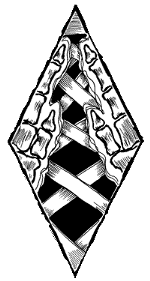
”Masquer” posted:
Stop twitching, this is delicate work. You paid heavy Pathos for quality, and I’m the best you’ll find. Ah, there we go. Excellent. Now try not to get those wings torn off -- I can’t promise that anyone could mend them and keep the incandescence going.
If the quote didn’t give it away, this is the power to mold soulstuff into new shapes. It basically turns a soul into wet clay for long enough to work it. It reminds me a bit of the Tzimice, without all the creepy ‘alien’ quality that got emphasized there. Easy stuff like tearing Corpus out of an opponent is nearly instaneous. Making a wraith into a fine seat-cushion can take minutes or hours.
These guys all have very malleable Corpus, and most start to look slightly too perfect.
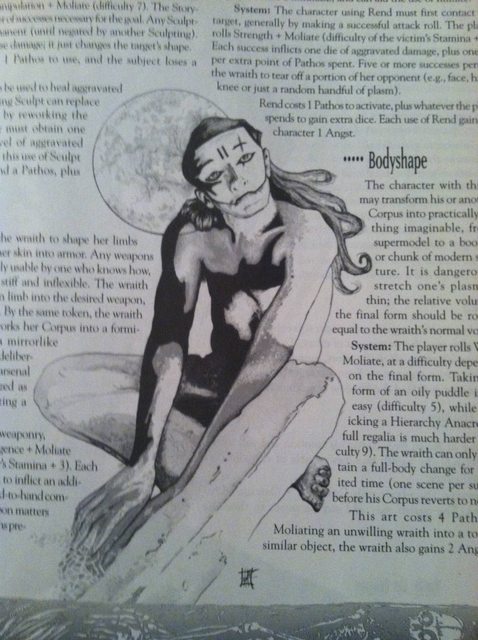
Guild
This used to be one of the big guilds, all about beauty and fashion. Lots of people used them for any number of things, so they were very well off. Highest ranks usually were warriors, assassins, and the like. They backed out of the Revolt early, which has caused a bit of mistrust, and pretty much ever known Masquer or anyone with talent for Moliate gets watched.
Botches
Usually these cause really bad screw ups to appearance, and they are not easy to fix. These will usually last or a scene.
Basic Abilities
-
Glow -- You can make yourself or another glow with any colour or intensity.
-
Return of Death’s Visage -- You can make anyone like they did when their Caul was first removed.
- Shapesense -- You can detect if another has been Moliated and how.
Main Powers
-
One Dot: Imitate -- You can make your face mimic another’s. It can be done from memory if necessary; it only changes your face.
-
Two Dots: Sculpt -- This is really the big one; you can change and shape wraiths to whatever form. It won’t create weaponry; you can give yourself a Bite attack though? Otherwise you maintain your regular stats. You can also use this to heal aggravated damage.
-
Three Dots: Martialry -- You can change your limbs to weapons and skin to armour. These are created automatically; armour is usually stiff and inflexible. You can make it as complicated as you want without sacrificing utility. You cannot use this on others; the banning of the Guilds caused it to be lost to the mainstream.
-
Four Dots: Rend -- You can tear the Corpus of another wraith. You can dismember, disfigure, or other fuck someone up. Some will tear off the face and keep it; it’s called a skinmask. Don’t mess with master Masquers is what I’m saying. They do take a point of Angst for it.
- Five Dots: Bodyshape -- You may transform your corpus or another’s into nearly anything you desire. The volumes should be fairly similiar, otherwise stretching it too thin can cause permanent damage to the soul. If you do this to someone who is unwilling you gain 2 Angst.
Outrage: The Spooks
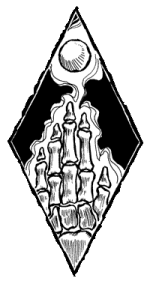
”Spook” posted:
RrrrrraaaaAAAAAHHH! Scare you, didn’t I?
These guys are all about brute force and damage. This is used primarily to affect the Skinlands, manifesting as kinetic energy. If you want to be a poltergeist you’ll need this. Every skill you learn is violent in some way.
They gain well-defined if oddly placed muscle groups.
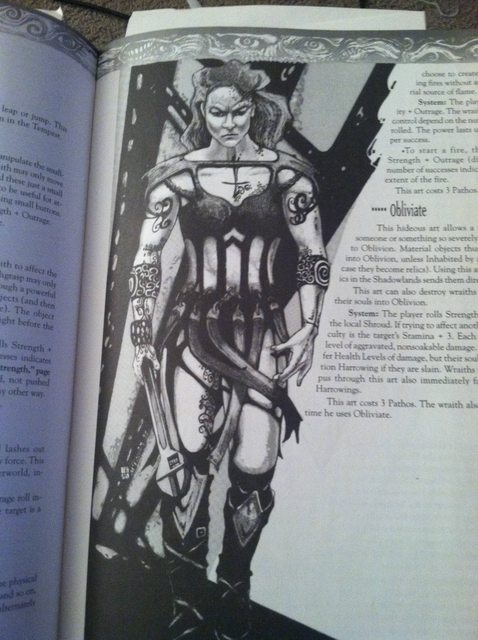
Guild
This was never really a guild, or at least not an organized one, plus there usually wasn’t a huge demand on their skills. Artificers usually had employment for them to aid in the creation of Artifacts. When the Revolt happened, they didn’t really notice or care so much. They can still be found fighting in the roughest parts of a city.
Botches
This will usually hit the wrong person or area. Very violent things might overfeed Angst to the Shadow. Definitely a Beserker class.
Basic Abilities
- Leap of Rage -- You can jump really far. That’s it.
Main Powers
-
One Dot: Ping -- You can manipulate small objects in the material world, around bottle cap sized. They only move small distances. You can totally press buttons on a keyboard and scare the crap out of some living person though.
-
Two Dots: Wraithgrasp -- You can lift things, and they can be most any size if you’re strong. You can only lift things, but that means you can still pick up a truck and hope someone walks under it so you can smash them.
-
Three Dots: Stonehand Punch -- You use your anger to strike across the Shroud. You can also use this on wraiths in the Underworld.
-
Four Dots: Death’s Touch -- You can manipulate objects in the physical world. You can also choose to create friction and make fire without any sort of material flame.
- Five Dots: Obliviate -- Everyone is scared of this skill. You can punch someone straight into Oblivion. You can also use this punch the living in if you want, though they take health damage first. If they do fall, they go into an immediate Destruction Harrowing. A wraith with zero Corpus immediately goes into one as well. You get 2 angst each time you use this because you are being super jerk.
Pandemonium: The Haunters
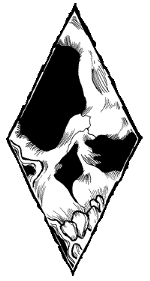
”Haunter” posted:
Look at that! Look at those folks scurry for safety! Who says there’s no bauty in discord? Whee!!
Fishmalk.
Ok, ok, I’ll go into a little more detail. I just think these guys are incredibly boring. These guys can make strange things happen, both in the Shadowlands and Skinlands. The worst effects are usually forgotten or denied by the living, what with how extravagant the effects can be. Difficulty will always be the Shroud unless specified.
They always seem very odd, and will adopt at least one ‘quirky’(read annoying) mannerism. A lot of them have started to wear big black cloaks as a theatrical device and to recognize each other.
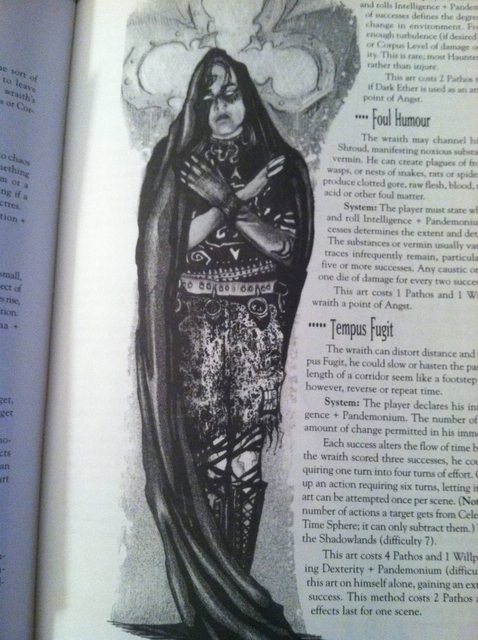
You just don’t get it, I bleed the 90s.
Guild
These guys usually only were ever associated with by Spooks, and that was to clear out areas. Otherwise no one wanted to hang out with these guys. They weren’t really affected by the Revolt at all, and you usually can find a Spook near a Haunter and vice versa.
Botches
This often will cause distortion in the area that wasn’t intended, or be used without causing any effects in the skinlands. Look, these are boring botches, try to be more creative.
Basic Abilities
- Sense Chaos -- You can notice if something is manipulated by Pandemonium or a Shadow.
Main Powers
-
One Dot: Weirdness -- You can cause something weird to happen. Good job.
-
Two Dots: Befuddlement -- You can make someone temporarily confused, making him forget what he’s doing.

-
Three Dots: Dark Ether. -- You can tamper with weather or light in a small area. This can make it suddenly start snowing in winter, modify humidity, or make a false fire. If used as an attack you get Angst. This is actually kind of neat.
-
Four Dots: Foul Humour -- You may channel your Corpus through the Shroud and create noxious substances or swarms of vermin. You can make it rain frogs. Or you can be super gross and make clotted gore, raw flesh, strong acid, ect. You get Angst for being so spooky.
- Five Dots: Tempus Fugit -- You can disort distance and time. You can’t reverse or repeat time though. It basically lets you do multiple actions on the same turn, or speed up an action that takes multiple turns. This is actually cool. It also notes it won’t add to Celerity, Rage, or Effects of the Time Sphere, only subtraction. And you can use it in the Shadowlands if you want.
Phantasm: The Sandmen
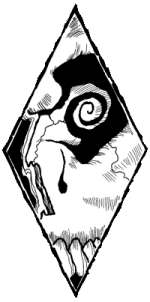
”Sandman” posted:
Surprised? You shouldn’t be. Are not all these things possible in dreams? Here, sit back under the Clockwork Tree. Have a sip from the flask of liquid daylight beside you. The Pageant of the Oneiric Ossuary is about to begin!
These people handle dreams; when you’re really good you can bring a sleeping mortal’s soul along to the Shadowlands. It’s pretty handy if you want to involve a mortal directly with what’s going on. Dreamers are wraiths with very solid wraiths; only stuff that would cause aggravated damage to a wraith or Artifact can hurt them. As soon as they are hurt the dreamer slips back to their body. Any of the abilities used to harmful effect will give the user 1 point of Angst.
They often have an overdramatic tilt and bearing. They prefer to wear clothes made out of gossamer, a material borrowed from dreams that shines slightly.
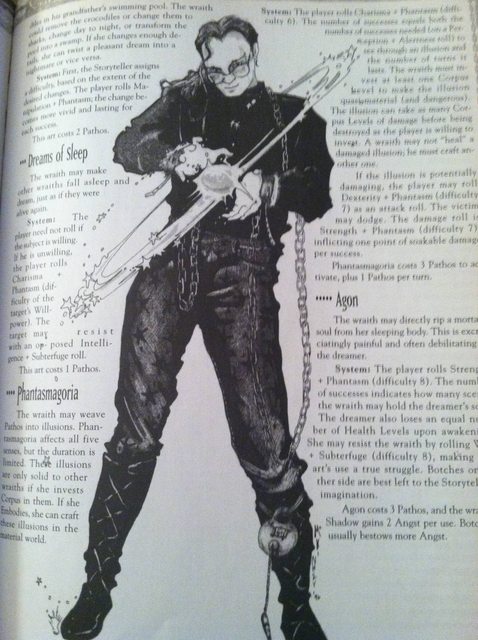
Guild
These guys were super popular pre-Revolt. They would have big theaters full of dreamers, which tons of Deathlords and Anacreons loved to watch. These guys love theater, so naturally that’s what they did. After the Revolt, they just made smaller troupes and kept traveling around.
Botches
This usually causes severe trauma for the dreamer, and can often lead to loads of Angst for the user. Illusions can spin out of control, the dreamer can gain recurring nightmares; the Shadow might also manage to take control, tormenting the dreamer.
Basic Abilities
- Sleepsense -- You can watch a mortal’s dreams and figure out where in the sleep cycle they are.
Main Powers
-
One Dot: Elysia -- You can take a sleeper’s soul and bring it to the Shadowrealm without hurting it. Then you can carry it around as you like.
-
Two Dots: Lucidity -- You can alter the details of a dream. You can change enough details to change how the dream is going, making it either nightmare or good dream.
-
Three Dots: Dreams of Sleep -- You can make other wraiths fall asleep and dream, just as if they were living. You only have to roll for unwilling subjects.
-
Four Dots: Phantasmagoria -- You can weave Pathos into illusions. They are only solid to other wraiths if you invest Corpus. Embodied wraiths can craft these in the material world.
- Five Dots: Agon -- You can rip a mortal’s soul directly from the body. This is incredibly painful and often causes severe trauma to the dreamer. This will gain you 2 angst per use, and more if you botch.
Puppetry: The Puppeteers
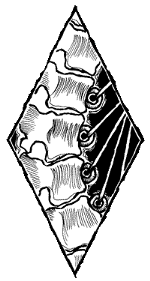
”Puppeteer” posted:
Mmmm. Don’t tell me you don’t remember what it felt like to be warm, to have blood pounding in your body. Oh, I see you remember. Wonderful, wasn’t it? We can feel that again, and more. Try holding someone else’s fluttering heart in your hands, or hearing her lover moan in your ear. I can never get enough of that....
These guys are arguably more creepy than the Monitors from last update. This one is pretty much explicitely forbidden by Charon, and only Deathlords and certain members of the Hierarchy are legally allowed to use it. When puppetting, a wraith is not affected by the Shadowlands at all; they take damage the host takes instead. The host’s skills and attributes take precedence for all tests unless the wraith takes direct control. Attuning naturally lowers the difficulty.
These guys usually pick up the accents and manners of those they skinride.
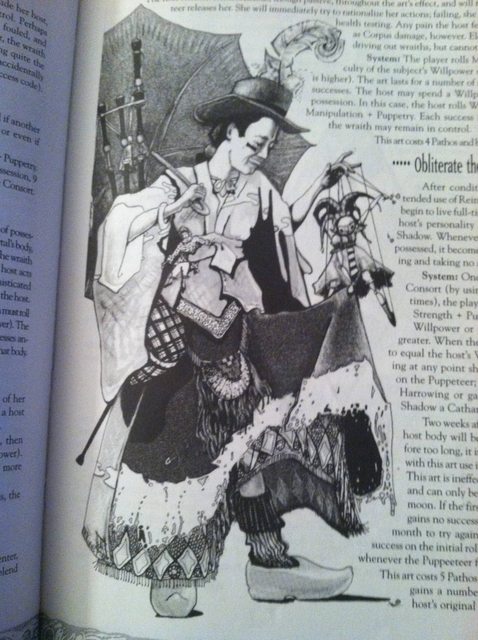
Guild
These guys were never an official member of society, though the guild existed. Charon even made use of them from time to time; he most tolerated them because of the Guild system. When they aided in the Revolt, he came down on them as hard as he’d been wanting to. In general, members now practice well away from the Hierarchy if they want to avoid the forges. Most develop a good deal of fondness for those they work with, and try to avert things that will cause the mortals harm; some of course, go for the opposite view.
Botches
This can trap a wraith inside her host, fuck up attunement and make you start over; incredibly drastic failures can cause the host to do the exact opposite of what they intended.
Basic Abilities
- Detect Possession -- A wraith can tell if a human is being skinridden.
Main Powers
-
One Dot: Skinride -- You can hop into a mortal’s body and get a brief ride. You can do nothing to control what’s happening; you have to do this first to do any other skills.
-
Two Dots: Sudden Movement -- You take momentary control of an arm or leg. Subtle use is good for manipulating objects in a way the host won’t notice--perhaps making them more skilled in instrument playing or the like. Get an Angst.
-
Three Dots: Master’s Voice -- You can override the speech centers and make the person speak. The voice is a blend of both wraith’s and host’s. This gives you 1 Angst.
-
Four Dots: Rein in the Mind -- You may possess a person without their knowledge. The host is usually semiconscious, and will regain control as soon as released. The host will try to rationalize anything she did while possessed, and will seek out therapy or mental health testing if she can’t. Pain will feedback to the wraith; electroshock is apparently good for removing wraiths for a time.
 You get a point of temporary angst.
You get a point of temporary angst.
- Five Dots: Obliterate the Soul -- You can condition someone through repeated use of Rein in the Mind to the point you can live inside their body full time. The host’s personality is cannibalized by the wraith’s Shadow. The body will go catatonic if the wraith leaves. Two weeks after the original soul is removed the body begins to decay. It doesn’t work against the supernatural. It’s only useable once a month on the new moon. One success is required otherwise you to wait a month to try again. This will gain you a number of Angst points equal to the host’s willpower.
Usury: The Usurers
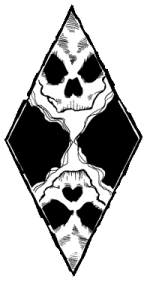
”Usurer” posted:
I’m glad we could come to an agreement. Seal the deal with a handshake, and I’ll get you what you need. I’m nothing less than fair, friend.
This is the Arcanos used for bartering Pathos, the other major currency of the dead. It allows for moving Pathos from one wraith to another. These guys have all sorts of reputations, depending on how honest the particular Usurer is. A lot of people distrust this Arcanos as well, saying it’s from the Shadow; it does raise Angst pretty quickly. You have to touch a subject to use this. If you want to affect mortals, you need to use other Arcanos.
These people tend to speak very precisely, in numerical terms. Most like to have some type of scales to keep track of balances as they are transferred.
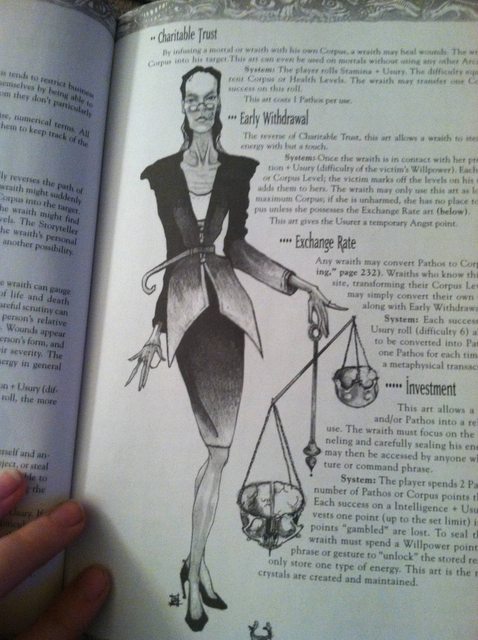
Guild
These guys had a lot of political power in their heyday, and no real surprise there. They cast in for the coup, but pulled out when they saw it would be failed. This left a lot of guilds without Pathos or Corpus resources they had expected. This was the major reversal that made sure the Revolt failed.
They usually are very secretive know since there’s a great deal of resentment. They usually lay oodles of weird clues to find them; even then they won’t deal with a client who was followed or doesn’t seem reliable. It keeps business lower, but it does mean they can charge more if they don’t like someone since there’s no where else to go.
Botches
This will usually reverse the path of transference, cause personal energy levels to fluctuate, or cause Health damage.
Basic Abilities
- Assessment -- You can gauge relative levels of life and death in someone. You can usually figure out something about Stamina, Health, or Corpus. It causes symbolic wounds to show up.
Main Powers
-
One Dot: Transfer -- You can move Pathos between yourself and another wraith. This is always visible to onlookers. If you use it to steal Pathos, you get a point of temporary Angst.
-
Two Dots: Charitable Trust -- You may heal wounds by infusing it with your own Corpus. You breathe heavily onto them to heal them. No, really. You can even use it on mortals.
-
Three Dots: Early Withdrawal -- This lets you steal life energy with a touch. You get a temporary Angst point.
-
Four Dots: Exchange Rate -- You may convert Corpus into Pathos (all wraiths know how to do the opposite). You can use it with Early Withdrawl if you want.
- Five Dots: Investment -- You may put Corpus and/or Pathos into a relic to store it for future use. It can be accessed by anyone who knows the seal’s gesture or command phrase. This is how soulfire crystals used for the forges are created and maintained.
And that is it for Arcanoi. For now. Unless I change my mind on the Player’s Handbook. In any case, we now know all the options for your basic wraith. Next time we discuss the finishing touch that has been referenced throughout this chapter, the Shadow.
The Voice in Your Head
Original SA post
Double post, let's put another update up. We're just gonna plow right on through.

Wraith: The Oblivion
Chapter 6: The Voice in Your Head
In a way, every single Wraith is legit insane. The darker urges has a voice, and it’s constantly egging them on to give up and fall to Oblivion, to destroy the things they love and strive for. It gets its own Passions to follow and feeds off the despair and suffering a wraith goes through.
Your shadow is controlled by a Shadowguide. The idea behind that is that you might know your dark side, but probably can’t control it. It looks like the major thing WW was going for with this mechanic was that it wouldn’t
matter
if your wraith was sitting on for a scene--you would still have things to do. I like the concept, though as everyone has picked up it’s a bit of a hard thing to do well and some groups would be turned off of it immediately.
Each Shadow will go through their own character creation, as they all have their own desires and features and how they present themselves. Some even give themselves a name. Character creation is very similar to how wraith chargen works. Storyteller involvement is encouraged, and you can involve your Shadowguide if you would like as well.
To start, you pick an
archetype
to define your Shadow. The archetype is literally just what flavour of abusive relationship you’d like to share. There’s a list of some sample ones available.
-
Abuser -- He’s constantly hurling abuse at people and looking for the best way to do so. He feeds on self-loathing, and will lash out at anyone that isn’t him. Excuses set him off, and he will make them up if you don’t give him one.
-
Director -- He’ll deconstruct you piece by piece, removing any delusions of what makes you good that you thought you had. He likes to go through all your past things and categorize every mistake, fault, and regret you’ve got, brought up with you when you aren’t expecting it and when it hurts most. When in control, he’s very good at poisoning people against you.
-
Freak -- He lives for all the stuff you are ashamed of doing. He encourages you to do all the things that you are ashamed of doing; as soon as you give in he makes fun of your perversion. If he gets control he’ll do all your worst desires in front of as many people as he can find.
-
Leech -- This guy is a whiner. Always whining and throwing tantrums, trying to get his way. He always wants more, and no matter what you give up, that price keeps going up. It tries to do the same thing when it’s in control, wanting everything.
-
Martyr -- She will always claim any sacrifice you make is for the greater good, and then demonstrate how it didn’t help at all and how pointless it was. When in control, she’ll put you in a situation where you have to give up something important to get out again, usually something publicly so that others will be hurt.
-
Monster -- All about the pain and greed, he’ll command you take anything you desire without regard for others. He wants you to destroy what he hates, and try to destroy you for getting in his way. This archetype is closest to the Spectres, and it’s not unusual for the calmest and quietest of wraiths to have this shadow.
-
Parent -- No one loves you as much, or cares as much for your well-being. She even loves your little faults, which she’ll harp on endlessly. She thinks everyone is a threat to you, and when in control will attempt to insulate and separate you from all those bad influences. She uses those she drives off as proof that no one cares quite so much as she does....
-
Perfectionist -- You need to be perfect. She demands it, and yet you never will be perfect enough. She will constantly harp on every tiny error you make, to the point that it magnifies into self-loathing for yourself. When in control, she’ll criticize everyone around you and make sure to embroil you in drama so she can watch you fail.
-
Pusher -- He’s always happy to help you achieve the impossible. He’s your best friend, and is
always
willing to help. The price is usually very high, but you can always pay later, with interest of course. Sometimes, when you count on him, he’ll withhold that help just to emphasize what a great help he is. In control, he’ll do everything to put you into situations where you need to call on his aid.
- Rationalist -- She will always give you all the right reasons for all the wrong decisions. She’ll lead you to Oblivion with all the proofs for the wisdom of everything she says, and make it seem so sensible . The more you agree, the tighter those chains get. It’s all about intellectual exercise, not personal involvement of the Director. When she’s in control, she’ll take steps towards getting you in the Void. Enjoy your new enemies and lost friends.
Naturally, you can make up your own flavours, but this is a very comprehensive and good list for the starting group.
Step two you pick out Angst . It’s the opposite of Pathos, which is positive energy you pick up. It’s all the negative baggage you get. Your shadow takes strength from that negative emotional energy, so the more troubled you are, the more strength your Shadow has. The permanent score always starts at or lower than willpower; you roll dice equal to willpower at difficulty 6. Each success is a permanent Angst point. 1s won’t cancel successes. You have to start the game with at least 1 point; if you lose all Angst you immediately Transcend.
As I explained before, you can get more temporary Angst than permanent, and you can trade 10 points in for a new point of permanent. When temporary is above permanent there is also the option to try to take control by means of Catharsis roll. The Shadow can spend temporary angst much like will power is spent for the wraith. The player wraith will not be privy to how much angst their shadowguide has. This number will vary wildly throughout play, as they can spend it on their own special powers (called Thorns ), Arcanoi often have temporary Angst, and Dark Passions the Shadow will feed as well. The Shadowguide must keep track of all of this.
I’m sure you’re starting to get an inkling of how much this game can make you hate your friends.
Step three is the selection of Dark Passions , what is driving your Shadow’s actions against you. When your Shadow gets closer to one of them, they get fed Angst, much as your passions would give you Pathos. These often are reversals of the regular passions, but can also be something unique, like trying to Cause Random Destruction. You pick a negative emotion as the core, and build around that. A wraith’s actions might also create a focus for a dark passion; someone skilled in Argos who takes people through the Tempest might have a Dark Passion of losing people to the Tempest.
In Step Four, you spend points on your Freebies . There are 10 to help round off the Shadow. The number of dots in Dark Passions cannot exceed how many dots are in Passions at this stage of the game. Thorns need to be purchased with Freebies in general. These can range in power, and are at disposal of the Shadowguide when playing. They may be used during Cartharsis rolls where applicable.
Here’s a brief bit on all the thorns
1-point thorns(all of these are 1 pt/lvl, up to 5):
-
Spectre Prestige -- Your shadow has respect and prestige among the Spectres.
-
Dark Allies-- Regularly communication and plotting with Spectres.
-
Tainted Relic -- A relic only available in Catharsis, and always has some significance to the wraith.
-
Infamy -- Memoriam for the Shadow, and it’s how much fear and loathing the wraith inspires in the living. Each time a wraith falls into Slumber, the Shadow gets temporary angst for it. Botches can led to the opposite effect.
- Death’s Sigil (max at 3) -- A sign of Oblivion on a wraith that manifests no matter where she goes.
2 point thorns
-
Shadow Traits -- Can purchase one dot of any Attribute or Ability, which are available only during Catharsis. Must be purchased with freebies at creation.
-
Aura of Corruption -- The Shadow makes the wraith’s presence unpleasant to other wraiths. Usually subtly disturbing. It raises all social interactions by +2 difficulty; only buy once.
- Shadow Call - Can summon nearby Spectres; must be in Tempest or near a Nihil. Audible as piercing shriek to wraiths in the vicinity.
3 point thorns
-
Pact of Doom -- The deal with the devil. The Shadow teaches a predetermined number of levels in an Arcanos. The Shadow gets permanent Angst equivalent to the levels taught. Both Shadow and Wraith must agree to this.The Shadow must have this trait in order to do a pact.
-
Trick of Light -- Alter the wraith’s perception of a scene subtly. Any sense may be altered, but only per scene. The Shadowguide will tell the Storyteller what the wraith perceives, which is told to the wraith.
-
Bad Luck -- For each Angst spent, a Shadow can choose what dice need to be rerolled by the wraith. This does not have to be announced until after the original roll. This move will lead to fights at the table. So. Many. Fights.
- Shadowed Face -- The Shadow may take on the Psyche’s appearance when it takes over. It allows for one other visage that can be either known or unknown to the wraith’s friends. An additional point spent will allow the choice between the original appearance or Shadow Face for Catharsis.
4 point thorns
Look, there’s only one of these, and I’m not formatting a list for just one. It’s Tainted Touch , and it makes it so the wraith becomes Typhoid Mary. It causes a wraith to spread Oblivion whenever it touches anyone else, and it gives temporary angst to the victim. You can turn it off for a scene with the spending of one willpower.
5 point thorns
-
Shadowplay -- A wraith who has used all actions may get another one at the loss of a point of Pathos and gain of Angst; the Shadowguide must offer to do so. The wraith can’t ask for it.
-
Shadow Familiar -- This is a minor servant of Oblivion serving as the eyes, ears, and feet. It is always in contact with the Shadow. It will be replaced in one week if destroyed; it will, however, be more cautious in dealings with the Shadow.
-
Freudian Slip -- The Shadow may spend one Angst to force the wraith to make an involuntary action or a quick, unedited statement. It can also be used to give thoughts to the wraith. Two willpower successes at difficulty 7 are required to counter the effects.
-
Shadow Life -- Whenever a wraith Slumbers, the Shadow takes control. The wraith has no way of knowing what the Shadow does during the time, though he knows the Shadow has taken control. The player will control the character while Shadow Life is active, but that doesn’t mean you can be nice to yourself.
7 point thorns, only one: Devil’s Dare . The Shadowguide invests a number of temporary Angst, immediately marked off, and writes down a dare for the Psyche to do before end of session. Difficulty determines cost; player may petition to have the number lowered if it’s unfair. It must be within capabilities to do, or else it’s a waste of Angst. If the possible action isn’t done by end of session, she will lose that many temporary Willpower. This can be morbidly fascinating, hilarious, and frustrating all at once--especially if you are just another player at the table.
Having seen all the thorns, the full sprawl of assholery that this mechanic can cause is pretty obvious.
This is all you need for shadow creation. The book runs through a sample creation, and the attention to detail and figuring out what works for you wraith is pretty close to what you should do. You shouldn’t try to make your Shadow super easy just because you’re scared; it’ll get stronger at some point no matter what you do now.
The rest of Shadow gen is some details on Shadow mechanics. I’ll run down points of note we haven’t covered yet.
It’s fairly easy to acquire Angst, as almost every type of Arcanoi has a method of getting some. Steps toward Dark Passions, Storyteller discretion (usually due with a well-done roleplay session if that is what would result, this one is more mutual consent), and Shadow Dice. These are dice the Shadow offers to pool in, with each success from the extra dice adding one point of temporary. A side bar tells us of some actions that may get Angst, but isn’t predetermined like other things: forced into an action against your moral code, a situation of helplessness or inner turmoil, failure to accomplish an important task, inaction at a critical moment, decisions that prove disastrous later, and so forth. Most of these are things your Shadowguide would jump on, too, leading to some interesting roleplay.
Losing Angst is slightly more difficult. Again, Storyteller discretion shows up, but also use of Castigate, botching a roll when the Shadow is dominant, and any Arcanoi that would generate Angst will instead subtract it if the Shadow is in charge.
Catharsis has been mentioned several times already, but here we discover what exactly it is and how it works. This is when a wraith loses herself to her Shadow, the Shadow managing to seize control of the character. The player will continue to run the character, but now has to act as the Shadow would. The Shadowguide may optionally play the Psyche’s view on this--this allows both players to get a feel for their opposite’s role. My group just ran with letting the Shadowguide stay in charge and Psyche sit back, as it made more sense to us to run it that way.
There is a roll involved in this--the Shadowguide rolls temporary Angst rating; the Psyche rolls permanent Willpower plus any Eidolon dice she has (remember that?). Difficulty is 6, most successes wins. Control will last one full scene. The Shadow can follow her own ends, use the Psyche’s Arcanoi, and so on. No Pathos can be gained during Catharsis and it cannot drop below 1, though the Shadow must expend it to power the Arcanoi. Willpower is inaccessible to the Shadow. If chosen, the Shadow can keep her actions secret from the Psyche; if you don’t have Eidolon or used all those dice, you get no save against this. Tough cookies.
The second half of this chapter is a much needed section on how to Shadowguide--tips, advice, and most of it is very good if you can remember it. Despite what I suspect, WW wasn’t trying to make you hate all your friends forever, and the whole mechanic is very cool. In fact, they spend the next few pages going and plastering big warning yellow tape over everything.
For instance, they mention you should sit down and talk with the wraith player your Shadowguiding for at the beginning of each session. If you guys don’t metagame too terribly, this is a good way to try and clear the air and lets everyone get a rough idea of how the other character is doing and let the Shadowguide get to know who they are playing better. The Shadowguide does need to know all of these things, because they are playing a being that should know everything about a wraith already. Shadowguide also plays as tempter to the Wraith. If you don’t houserule the Shadowguide plays during Catharsis, the Shadowguide will also advise the regular player on what sorts of the things the Shadow would likely do.
There’s suggestion to make some sort of vocal differentiation between Shadow and wraith, since you are playing both. We all opted for whispering or a voice to indicate it, though the book suggests a mask or little figurine to hold to help. This is pretty important. WW also points out you don’t always need to play the Shadow all the time, and it’s a very good rule--Shadowguide when you see the most effective moments, play your wraith otherwise.
There’s an entire section about how you shouldn’t be a jerk to the player, but the character, how you shouldn’t be constantly overbearing so your own wraith isn’t played, and how you should try to keep on clues so you know when your overwhelming the person you Shadowguide for. These are very good things to do. It even suggests communicating when you are feeling a bit too uncomfortable with your Shadow . My goodness. And it also says the Storyteller should intervene if they sense things are going too far.
Time out breaks to cool off and relax a little can be very important to a good time with Wraith, especially when you hit those super tense climax moments where everyone is very involved. This is advice from personal experience, not WW. We usually would have at least one or two breaks (1 every 1 to 2 hours) each time we met up, and I think the idle chatter helped to make everyone realize that no one was really out to get anyone else.
And know when to call it a night.
The Storyteller is always in charge of the game. If desired, impose a rule for how many times people can Shadowguide per session. If a Storyteller feels a Shadowguide is getting out of line, it’s the Storyteller’s job to say ‘Enough shit’. It’s an escalating scale--tell them in private, call them out politely at the table, and then revoke rights to Shadowguide. You can even do away with Shadowguides all together and just control the players’ Shadows for them. You can do in-game mechanics to make the Shadowguide realize that they are being over enthusiastic, including lowering all Shadow resist rolls by 3 or Storyteller controlled Castigation.
Small sessions or talks about Shadowguiding can also help bring to light any issues and let people get stuff off their chest and help a Storyteller to maintain a balance.
We get a good list of do’s and don’ts as well. Every single person in my group had a photocopy of this list. We might not have gone over it all the time, but it was attached to our sheet for the Shadows we Shadowguided, and we all looked it over more than a few times.
”White Wolf” posted:
- Avoid annoying the player whose Shadow you control. Shadow the character, not the player.
- Choose your opportunities for temptation carefully. Rather than broadsiding your Psyche with general enticements, find out what makes your Shadow’s Psyche tick and exploit those weaknesses at appropriate times.
- Don’t play your Shadow character at the expense of your own wraith character. If you find yourself Shadowguiding more than a quarter of the time, you’re short-changing your own character.
- Embarassing another player is not fun for anyone. Try to avoid abusing your power as Shadowguide to cause discomfort for the player of your Shadow’s Psyche.
- Find out if the player whose Shadow you control has a problem with dealing with certain topics or phobias, and avoid those when you are acting as Shadowguide. Do not spoil the game for another player.
- Keep in mind the Shadow you are playing is a small part of a larger game, and try to keep your actions directed to increasing the drama and enjoyment of the game for yourself and other players.
- Make sure you differentiate between your character’s voice and that of the Shadow you are playing.
- Remember that the player of a wraith’s Psyche controls her character regardless of whether or not the Psyche or the Shadow is dominant. Do not attempt to play someone else’s character just because you are playing her Shadow.
- Try to make your Shadow’s words and actions entertaining as well as effective. Others are watching what you do.
Look at that. Whitewolf knew what they were doing sometimes.
Anyway, enough Shadowguide Advice 101, let’s finish out this chapter.
Harrowings!
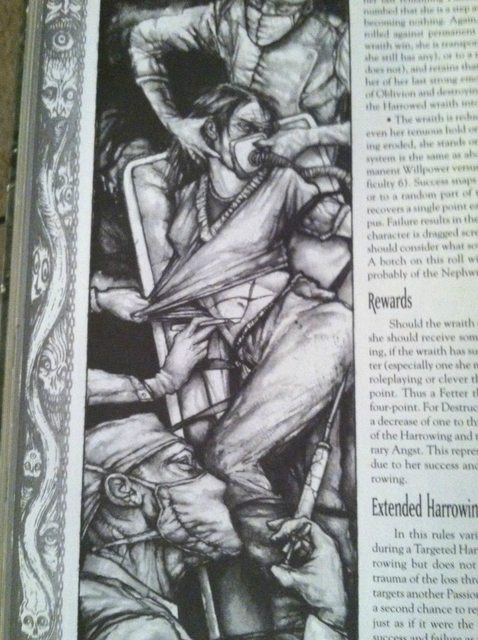
Have a picture of a harrowing, which horrified me and still gives me the creeps because I’m slightly terrified of medical torture. Also we needed to break up the wall o’ text.
Harrowings have come up several times before, without much knowledge what they are and what that means. They occur in the Tempest. Think of it as a highly personalized passion play with you stuck in the center, directed by your Shadow just for you , with Spectres as the actors. It’s designed to make your wraith fall, to destroy something important, to force you that much closer to Oblivion. The Shadow wants to stack the choices so you pick incorrectly or are too afraid to pick any and can ‘win.’ Course, the wraith can triumph too, though it will almost always leave them changed.
At one point, long ago, getting a wraith to let go of her Passions and Fetters was so they could Transcend, challenges designed to teach a wraith how to contend with the darkness and win. They served as a cathartic experience, to teach them so they could begin to face what they needed to do so they could pass on.
Now, they aren’t so pretty. They are entirely focused around dragging you screaming to Oblivion, and no one is sure when they took that darker turn.
The way they work is the wraith lands in a nightmare landscape with basically dream rules. She can use any Arcanoi, willpower (to the last point but not the last point), and any abilities--they won’t let her escape though. She has to see the whole thing through to the end.
There are a few reasons for a Harrowing happening, which we’ll cover in a few minutes. Once one of the conditions for a Harrowing is met, she is immediately dragged down, a personal Nihil opening up. The Shadow will let nearby Spectres know all about what makes the wraith tick, so that the stage is ready to go when the wraith arrives. Items and scenes can change in the blink of an eye, all under the direction of the Shadow. Once over, the wraith is immediately dragged back to where she needs to go--be it back to the Shadowlands or Oblivion.
On leaving, if the character did not successfully role play her way out, there is a roll to determine success, failure, or botch. It is not made till after the Harrowing and reaction to it. If you roleplay and get at the core of the Harrowing, you succeed without a dice roll. You cannot auto-fail or botch without a dice roll. Some sort of escape must always be present for the wraith, no matter how poorly the roleplaying is. You can adjust difficulty, whatever, but don’t take the roll away.
If after a preset time the Harrowing isn’t resolved (10--15 is a good average), the drama is auto resolved by the Storyteller and the roll is done. It’s permanent Willpower at difficulty 9, with a single success enough to escape. Difficulty may be adjusted if good roleplaying was done even if she didn’t succeed. Again, no roll if you succeed at the harrowing.
Eidolon can be used to help change the Harrowing in the wraith’s favour. Willpower can be used to get automatic successes. If you are in the Harrowing because you are on the last point of willpower, you may not use that--it means you give up and you immediately go to Oblivion.
The Spectres are played by other people at the table (yes we need another way to hate each other). Again, emphasis on not trying to get even or revel in being ‘evil’. Storytellers need to be on the ball here; if they note sadism directed at player instead of wraith, they should sideline the ‘spectre’ and that player can’t rejoin until the Harrowing is resolved. Usually it helps to take aside the group who will be acting in the Harrowing and explaining what will be going on, and setting up terms on how the player succeeds. And if they need it, make it obvious that one day their player is going to fall into a Harrowing too, and they certainly don’t want to be on the revenge end of that stick.
There are two different types of Harrowings, and they involve slightly different targets and outcomes. We’ll look at them, and then an example of one.
Target Harrowings are when the Passions or Fetters are targeted by the Shadow in an attempt to destroy it. The target is called the Quarry. These events activate this:
-
You lose or use up all your Willpower. Just as you are about to lose the final point, you immediately fall into the Harrowing. Shadowguide picks whether a Fetter or Passion--usually a low-level trait.
Success means you lose no points off the Quarry, are snapped back to one of your Fetters, and keep that last point of Willpower. Failure results in rolling dice equal to how many points in the Quarry you have at Difficulty 8, and you lose the number of points that don’t come up with success. If the total points of the Quarry hit zero, you lose it forever. You escape, snap back to a Fetter (if you have any left), and regain Willpower equal to your Intelligence rating. Botch results in losing the Quarry outright, and you must roll against the Shadow’s Angst with your permanent willpower at diff 6. If the Shadow wins you lose one point of permanent Corpus.
If the Storyteller thinks you lost the Willpower by spending it willy nilly you may be thrown in a Destruction harrowing instead.
-
You are on the verge of losing your last point in an individual Passion (not Resolving). When the last point is threatened, you undergo the Harrowing. Wraiths can lose Passions due to failing, but it isn’t recommended to force a second harrowing for failing one of these.
The theme should involve the Passion, and it must be the Quarry. Success is the same as in the prior. Fails or botches will lose the Quarry and you must roll again against a different Passion. Any failures will subtract from this Passion. Botches must roll permanent willpower vs permanent Angst or lose permanent Corpus.
-
On the verge of losing (not Resolving) last point of a Fetter. It is the same as with a Passion, only the Fetter Quarry is centered in the nightmare. Success is the same as the Passion. Failure and botches are handled the same; if it is the last Fetter, though, you are thrown into the Tempest instead of to a Fetter. Success will not reverse destruction or death of a Fetter if that’s what caused the Harrowing, but it does let you consider it resolved instead of destroyed.
-
You lose all your temporary Corpus. The wraith is the Quarry. Success will allow escape to a Fetter and restoration of temporary Corpus equal Stamina. Failure means loss of 1 point permanent Corpus, botch results in a second immediate Harrowing, wraith as Quarry.
Don’t botch.
If you lose your last point of permanent Corpus due to this Harrowing, you are immediately thrown into a Destruction Harrowing.
Destruction Harrowings are bad news, and you really don’t want to end up here. Really. This is one step away from permadeath. You have either been extraordinarily unlucky or doing something wrong to end up here. You are always the Quarry in these.
Reasons you end up here:
-
You have pissed your Storyteller off by spending your willpower on useless, pointless things and probably played like a jerk with the rest of the troupe and have no willpower left. You must make an opposed roll with permanent Willpower vs permanent Angst. Success will allow you to escape with one willpower. Failure means you are consumed by Oblivion. Botch can lead to rebirth as a wraith (Storyteller discretion. Honestly, if you did something to justify this type of Harrowing, I wouldn’t reward your bad behaviour with more attention).
-
You are on the verge of losing your last point in your last remaining Passion. Permanent willpower against Angst for roll. Success, go to Fetter or Tempest, keep Passion. Failure destroys. Botch = possible Spectre. This is the most depressing way to go, and usually is from a horrible backslide that you struggle to get out of. I lost one character to this, and I’m surprised I kept playing until it hit this point, but it lined up neatly with the end of that story, and cast a sort of pall over things for the remaining troupe. (I really just rolled for damn shit with that character, and took a turn Storytelling for a few sessions for a more light hearted game until we were all up to keep going with Wraith).
-
You hit zero permanent Corpus. This is a spiral sort of failure, and sucks. Same system as before, success gives Fetter or Tempest, and you get a single point of both temporary and permanent Corpus. Failure = destruction. Botch is Spectredom, most likely a Nephwrack (we’ll cover the types of Spectres soon, if I keep up this pace of updates).
Rewards are suggested for those who successfully overcome their Harrowing. Maybe you get an extra point for defending a Fetter or Passion, maybe you get temporary Angst decreased. This is a boost of confidence, but it’s really a sweet reward after something stressful as a player.
You can alter the rules some and use extended harrowings, doing a second with a different passion or fetter if you don’t want to take a point of Permanent corpus from a failure; it’s a sort of redemption step. If they fail again, then take the corpus away.
Group harrowings are pretty rare--usually from loss of a shared Fetter or suddenly Corpus strip by Maelstrom or fight. The mechanics are similar, though Storyteller does all the parts since the players are all involved. All either succeed or must roll for outcome. Some individuals can fail; if it’s a shared Fetter you can choose an all-together approach and all pass or fail. Highest ranking Fetter holder gets to roll for the group; fail means next highest rolls the willpower test. Second roll success means no harm, fail means everyone loses one point of Corpus. If you do an everyone roll, you can have just the failures lose the corpus and fetter.
Finally, we’ll show an example of how to construct a Harrowing, straight from the book.
”Harrowing sidebar” posted:
While Erik is still climbing over the edge of the building, the shot fired by the first Heretic attracts the attention of a couple of his friends. They all open fire on the unfortunate wraith, and their relic bullets connect. Erik loses his grip on the ledge and falls to the unforgiving ground.
The storyteller rules that between the bullets and the impact with the ground, Erik has taken enough damage to land in a Harrowing. She asks Erik’s player to leave the room, and once that occurs, asks Erik’s Shadowguide what would make a good target for the Harrowing.
The Shadowguide points to Eirk’s biggest Passion, tied up with his quest for the wraith he’s fallen in love with but who was enthralled soon after. He also mentions that Erik’s Nature is Martyr, and that it might be a good idea to make the escape condition that Erik has to refuse, consciously, a pointless self-sacrifice. The Storyteller agrees that this would make for good Harrowing material, and in conjunction with the other players, she decides to present Erik with multiple Spectral images of his lost love in soul-threatening peril. He can save on, possibly two, but he can’t save them all, and trying will only get him destroyed to no end. Satisfied that all the other players are comfortable with their roles as Spectres in the Harrowing, the Storyteller calls Erick back into the room....
And that’s a really good example to follow. At first they seem hard to construct, but it helps to always refer back to the character sheet.
Whew! That’s a lot of words, but I wanted to do chapter 6 in one go. I think it’s an extremely important chapter, and it offers a great deal of advice on one of the things that makes wraith so unique. It also flat out says that if you don’t think your troupe can handle it, make the Storyteller in charge of the Shadows. Your Storyteller should be fair already, so while they may show up less, you don’t have to worry about all your players hating each other.
Next Time: Story Teller advice. This is gonna be a much shorter update, as most of it has been covered in side bars prior.